哈工大深圳组合数学第六章习题答案
- 格式:pdf
- 大小:112.78 KB
- 文档页数:6
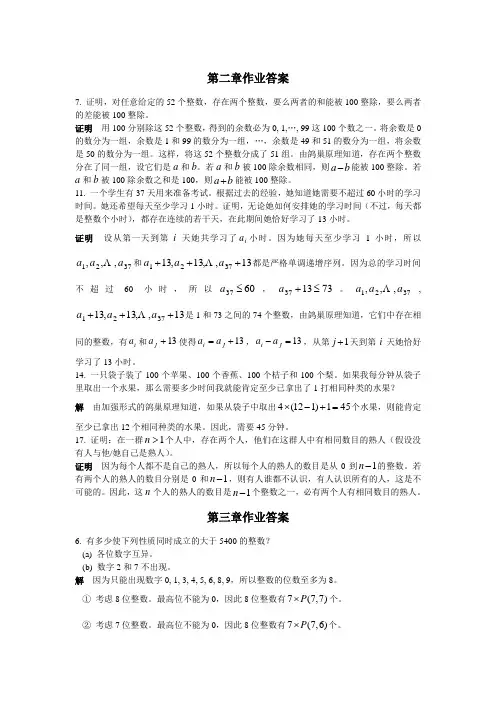
第二章作业答案7. 证明,对任意给定的52个整数,存在两个整数,要么两者的和能被100整除,要么两者的差能被100整除。
证明 用100分别除这52个整数,得到的余数必为0, 1,…, 99这100个数之一。
将余数是0的数分为一组,余数是1和99的数分为一组,…,余数是49和51的数分为一组,将余数是50的数分为一组。
这样,将这52个整数分成了51组。
由鸽巢原理知道,存在两个整数分在了同一组,设它们是a 和b 。
若a 和b 被100除余数相同,则b a -能被100整除。
若a 和b 被100除余数之和是100,则b a +能被100整除。
11. 一个学生有37天用来准备考试。
根据过去的经验,她知道她需要不超过60小时的学习时间。
她还希望每天至少学习1小时。
证明,无论她如何安排她的学习时间(不过,每天都是整数个小时),都存在连续的若干天,在此期间她恰好学习了13小时。
证明 设从第一天到第i 天她共学习了i a 小时。
因为她每天至少学习1小时,所以3721,,,a a a 和13,,13,133721+++a a a 都是严格单调递增序列。
因为总的学习时间不超过60小时,所以6037≤a ,731337≤+a 。
3721,,,a a a ,13,,13,133721+++a a a 是1和73之间的74个整数,由鸽巢原理知道,它们中存在相同的整数,有i a 和13+j a 使得13+=j i a a ,13=-j i a a ,从第1+j 天到第i 天她恰好学习了13小时。
14. 一只袋子装了100个苹果、100个香蕉、100个桔子和100个梨。
如果我每分钟从袋子里取出一个水果,那么需要多少时间我就能肯定至少已拿出了1打相同种类的水果? 解 由加强形式的鸽巢原理知道,如果从袋子中取出451)112(4=+-⨯个水果,则能肯定至少已拿出12个相同种类的水果。
因此,需要45分钟。
17. 证明:在一群1>n 个人中,存在两个人,他们在这群人中有相同数目的熟人(假设没有人与他/她自己是熟人)。
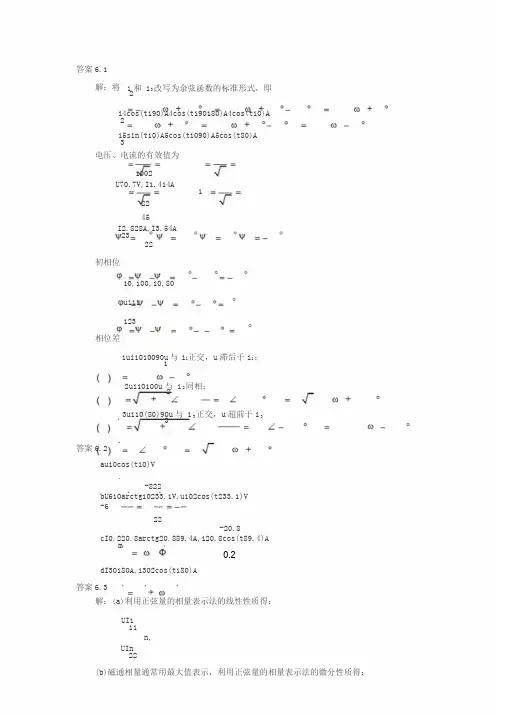
答案6.1解:将i和i3改写为余弦函数的标准形式,即2i4cos(t190)A4cos(t190180)A4cos(t10)A2i5sin(t10)A5cos(t1090)A5cos(t80)A3电压、电流的有效值为1002U70.7V,I1.414A12245I2.828A,I3.54A2322初相位10,100,10,80uiii123相位差1ui1010090u与i1正交,u滞后于i1;12ui10100u与i2同相;23ui10(80)90u与i3正交,u超前于i33答案6.2au10cos(t10)V.-822bU610arctg10233.1V,u102cos(t233.1)V-622-20.8cI0.220.8arctg20.889.4A,i20.8cos(t89.4)Am0.2dI30180A,i302cos(t180)A答案6.3解:(a)利用正弦量的相量表示法的线性性质得:UI111n,UIn22(b)磁通相量通常用最大值表示,利用正弦量的相量表示法的微分性质得:UjNmm(c)利用正弦量的相量表示法的线性性质与微分性质得:URIjLI答案6.4解:由KCL得电流i的振幅相量IIIIm1m2m3m(2100410580)A(0.347j1.973.939j0.6950.868j4.924)A526.86A电流i的瞬时值为i5cos(t26.86)A答案6.5解:电压表和电流表读数为有效值,其比值为阻抗模,即2()2/RLUI将已知条件代入,得22R(2π50L) 100V 15A22R(2π100L)100V 10联立方程,解得L13.7mH,R5.08答案6.6解:(a)RC串联电路中电阻电压与电容电压相位正交,各电压有效值关系为2222UU2U15040V30V电流i的有效值为IIC UXC30V103A(b)UXICC302A60VI R UR60V500.3ARC并联电路中电阻电流与电容电流相位正交,总电流有效值为22221.222.33IIIAACR(c)UXI301A30VCCC由U30VCUUXII2ALCLLX15L并联电容、电感上电流相位相反,总电流为III1ALC电阻电压与电容电压相位正交,总电压为:2230240250UUUVVCR答案6.7解:感抗XL L3210rad/s0.1H200容抗X C 11C36210rad/s510F100图(a)电路的相量模型如图(b)所示。
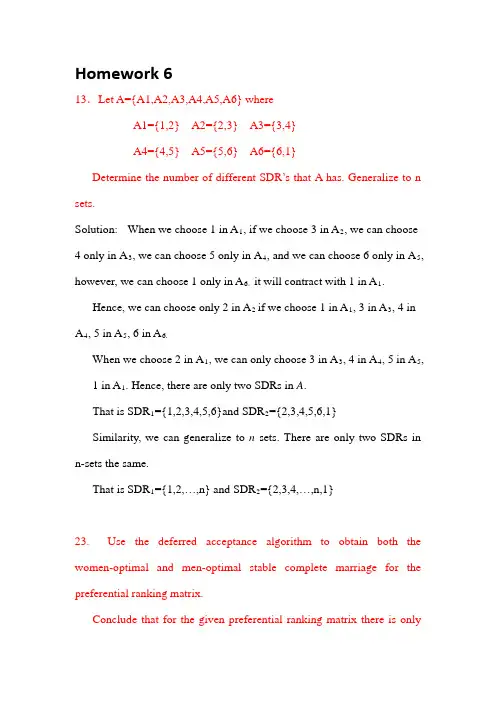
Homework 613.Let A={A1,A2,A3,A4,A5,A6} whereA1={1,2} A2={2,3} A3={3,4} A4={4,5} A5={5,6} A6={6,1}Determine the number of different SDR’s that A has. Generalize to n sets.Solution: When we choose 1 in A 1, if we choose 3 in A 2, we can choose 4 only in A 3, we can choose 5 only in A 4, and we can choose 6 only in A 5, however, we can choose 1 only in A 6,it will contract with 1 in A 1Hence, we can choose only 2 in A .2 if we choose 1 in A 1,3 in A 3,4 in A 4,5 in A 5,6 in A When we choose 2 in A 6.1, we can only choose 3 in A 3, 4 in A 4, 5 in A 5, 1 in A 1That is SDR . Hence, there are only two SDRs in A . 1={1,2,3,4,5,6}and SDR 2Similarity, we can generalize to n sets. There are only two SDRs in n-sets the same.={2,3,4,5,6,1}That is SDR 1={1,2,…,n} and SDR 2={2,3,4,…,n,1}23. Use the deferred acceptance algorithm to obtain both the women-optimal and men-optimal stable complete marriage for the preferential ranking matrix.Conclude that for the given preferential ranking matrix there is onlyone stable complete marriage.a b c dAA BB CC DD�1,32,3 1,44,13,24,33,32,2 2,21,4 4,12,23,44,13,11,4�Solution:(1) women-optimalThe results of the algorithm are as follows:1)A choose a, B choose a, C choose b, D choose d; a rejects B2)B choose d; d rejects D.3)D choose b; b rejects C.4)C choose a; a rejects A.5)A choose c.In 5), there are no rejections, and(2) men-optimalThe results of the algorithm are as follows:1)a choose D, b choose B, c choose D, d choose C; D rejects a.2)a choose C, C rejects d.3)d choose B, B rejects b.4)b choose D, D reject c.5)c choose A.In 5), there are no rejections, anda C,b D,c A,d B.Conclude that, for given preferential ranking matrix, there is only one stable complete marriage.3. Consider an m-by-n chessboard where at least one of m and n is even. The board has an equal number of white and black squares. Show that if m and n are at least 2 and if exactly one white and exactly one black square are forbidden, the resulting board has a perfect cover with dominoes.Solution:Let n be even, there are even numbers of columns. From top row, if the top row has no squares forbidden, then that row can be covered by dominoes. So we can remove this row. Repeat this till the new top row has a forbidden square. Do the same thing from the bottom row. So we can assume that forbidden squares are on the top and bottom rows.Let’s consider the first two columns from the left. If there is nofirst two columns, they can be covered by forbidden square in thedominoes and we can remove them. Repeat this till there is a forbidden square in the first two columns. Do the same from the right side so we ca n also assume the forbidden squares lie in the first two columns and the last two columns. After the above have been done, we can assume that chessflip board is of one of the following three situations (with rotation or ofover the chess board if needed). In each of the case, there are even numbers of columns.(A) (B) (C)So the two forbidden squares have one black and the other white, there are even numbers of columns. We draw the figures, in the cases (A) and (B), there has to be odd number of rows while in the case (C), there are even number of rows. Then we divide the board into pieces as shown in the following such each piece is rectangular with at least one side being even, thus can be covered by dominoes respectively.So the entire board has a perfect cover by dominoes.(A) (B) (C)4. Determine the max-matching and the min-cover of the right graph by applying the matching algorithm. We choose the red edges and obtain a matching M1.Find a minimum edge cover for the right graph.Answer:Now we get the matching )},(),,{(44121y x y x M = and U 131,x x = {}. (i) The vertices 31,x x are labeled (*).x 1y 1x x y 2 y 3 y 4y 5(ii) Scan the vertices in U 154321,,,,y y y y y in turn, and label with (1x ), since all vertices incident to 3x .already have a label, no vertex of Y get label (3x ).(iii) Scan the vertices 5431,,,y y y y labeled in (ii), and label 2x with (1y ), label 4x with (4y ).(*)x 1y 1(1x )x(*)x 3x y 2 y 3(1x ) y 4(1x )y 5(1x )(*)x 1 y1x (*)x 3x y 2 y 3 y 4y 5(iv) We scan the vertices 2x and 4x labeled in (iii), and label 2y with (2x ).(v) Scan the vertices 2y labeled in (iv), and find that no new labels are possible.We have achieved breakthrough. We find the 1M -augmenting path11221x y x y r = using the labels as a guide. Then )},(),,(),,{(4411222y x y x y x M =(*)x 1y 1(1x )(1y )x 2(*)x 3(4y )x y 2(2x ) y 3(1x ) y 4(1x )y 5(1x )(*)x 1 y 1(1x )(1y )x 2(*)x 3(4y )x y 2 y 3(1x ) y 4(1x )y 5(1x )and }{32x U =.(vi) The vertices 3x are labeled (*).(vii) Scan the vertices in U 25y in turn, and label with (3x )x 1y 1x 2(*)x 3x 4y 2 y 3 y 4y 5x 1y 1x 2x 3x 4y 2 y 3 y 4y 5(Viii) Scan the vertex 5y labeled in (vii), and find that no new labels are possible.We have achieved breakthrough. We find the 2M -augmenting path352x y r = using the labels as a guide. Then)},(),,(),,(),,{(441122533y x y x y x y x M =is a matching of four edges.Now we can get thatx 1 y 1x 2x 3x 4y 2 y 3 y 4y 5x 1 y 1x 2(*)x 3x 4y 2 y 3 y 4y 5(3x )the max-matching )},(),,(),,(),,{(44112253y x y x y x y x M = and the min-cover= {54321,,,,y y y y y }.2) Find a minimum edge cover for the right graph.Follow the steps above; we can get a max-matching)},(),,(),,(),,{(44112253y x y x y x y x M =.And we can find that there are also some vertices uncovered by the max-matching. Obviously, the vertex 3y Now we can construct a subgraph composed of edges incident to the vertex is uncovered.3y , we find the max-matching of the subgraph, and add it to the max-matching of M, then we can get a minimum edge cover.Fig The subgraphThe max-matching of the subgraph is {(x 1,y 3)}. Now we can get a minimum edgecover={(x 1,y 3)}∪M ={(x 1,y 3)(x 3,y 5)(x 2,y 2)(x 1,y 1)(x 4,y 4)}x 1y 1x 2x 3x 4y 2 y 3y 4y 5x1y1x2 x3 x4y2 y3 y4y5Fig The minimum edge cover第八次作业16. Apply the algorithm for the GCD in Section 10.1 to 15 and 46, and then use the results to determine the multiplicative inverse of 15 in Z46Answer:.The result for Computing the GCD of 15 and 46 are displayed in the following:Now ,we write as a linear combination of 15 and 46:1=46-3*15From the above, 1 is the GCD of 15 and 46.Thus, we can get the multiplicative inverse of 15 in Z4615:-121. Determine the complementary design of the BIBD with parameters bb=vv=77,kk=rr=33,λλ=11in Section 10.2= – 3 = 43.•b: the number of blocks;•v: the number of varieties;•k: the number of varieties in each block;• r : the number of blocks containing each variety• λλ: the number of blocks containing each pair of varieties. Answer:Apply ()11−−=k v r λ to this case, now we have b =v =7,k =r =3,λ=1.Hence, we can get ()()311717111≠=−−×=−−=k v r λ. Thus, we can design such a complementary.We can get the complementary design of the BIBD withparametersb’ = b = 7, v’ = v = 7, k’ = v-k = 4, r’ = b-r = 4 ,213272'=+×−=+−=λλr b .28. Show that BB={00,11,33,99}is a difference set in Z13 Answer:, and use thisdifference set as a starter block to construct an SBIBD. Identify the parameters of the block design.We compute the subtraction table and obtain:We can find that non-zero integers in Z13}{9,3,1,0=B occur exactly once as adifference, hence is a difference set in Z1332. Use Theorem 10.3.2 to construct a Steiner triple system of index 1 having 21 varieties..•Hints:• 1. construct two Steiner triple systems B1 and B2• 2. construct B based on B with 3 and 7varieties, respectively.1and B2. Answer:1)Construct two Steiner triple systems B1 and B2 with 3 and 7 varieties, respectively.Let X={a0,a1,a2}and Y={b0,b1,b2,b3,b4,b5,b6}be two sets of varieties.Let B1={a0,a1,a2}and B2=�{b0,b1,b3},{b1,b2,b4}, {b2,b3,b5},{b3,b4,b6},{b4,b5,b0},{b5,b6,b1},{b6,b0,b2}�be the Steiner triple systems of X and Y, respectively.2)Construct B based on B1 and B2.We define a set B of triples of the elements of X. Let {c ir, c js, c kt} be a set of 3 elements of X. then {c ir, c js, c kt} is a triple of B iff one of the following holds:i) r = s = tIf r=s=t=1, we can get {0,3,9}, {3,6,12}, {6,9,15}, {9,12,18}, {12,15,0},{15,18,3}, {18,0,6};If r=s=t=2, we can get {1,4,10}, {4,7,13}, {7,10,16}, {10,13,19},{13,16,1}, {16,19,4}, {20,1,7};If r=s=t=3, we can get {2,5,11}, {5,8,14}, {8,11,17}, {11,14,20},{14,17,2}, {17,20,5}, {20,2,8};ii) i = j = k, We can get {0, 1, 2}, {3, 4, 5}, {6, 7, 8},{9, 10, 11}, {12, 13,14}, {15, 16, 17}, {18, 19, 20};(iii) i, j and k are all different and {a i, a j, a k} is a triple of B1, and r, s and t are all different and {b r, b s, b t} is a triple of B2. Put another way, c ir, c js, and c kt are in 3 different rows and 3 different columns of the array, and the rows in which they lie correspond to a triple of B1 and the columns inwhich they lie correspond to a triple of B2 If {a .i, a j, a k If {a }={0, 1, 3},we can get {0, 4, 11}, {0, 10, 5}, {3, 1, 11}, {3, 10, 2}, {9, 1, 5}, {9, 4, 2};i, a j, a k If {a }={1, 2, 4}, we can get {3, 7, 14}, {3, 13, 8}, {6, 4, 14}, {6, 13, 5}, {12, 4, 8}, {12, 7, 5};i, a j, a k If{a }={2, 3, 5},we can get {6, 10, 17}, {6, 16, 11}, {9, 7, 17}, {9, 16,8},{15,7,11},{15,10, 8};i, a j, a k If {a }={3,4,6}, we can get {9,13,20},{9,19,14},{12,10, 20},{12,19,11},{18,10,14},{18,13,11};i, a j, a k If {a }={4, 5, 0},we can get {12,16,2}, {12, 1,17}, {15,13,2},{15,1,14}, {0,13,17}, {0,16,14};i, a j, a k If {a }={5,6, 1},we can get {15, 19, 5},{15,4,20},{18, 16, 5},{18, 4, 17},{3,16,20},{3,19,17};i, a j, a k}={6,0, 2},we can get {18, 1, 8}, {18, 7, 2}, {0, 19, 8}, {0, 7,20}, {6, 19, 2}, {6, 1, 20};52. Construct a completion of the 3-by-6 Latin rectangleAnswer:According to theorem 10.4.11(390页), this 3-by-6 Latin rectangle has a completion. Let X={x 0, x 1, x 2, x 3, x 4, x 5} representing the 6 elements, and Y= {y 0, y 1, y 2, y 3, y 4, y 5} representing the columns. An edge (x i, yj ) in denotes element i doesn’t appear in column j. Then we construct a regular of degree 3 Bipartite graph of X and Y ,G=(X, Δ, Y) as follows.y 2x 0x 2x 3x 4y 1y 3x 1y 5y 4y0x 5(1)Computing the perfect matching using the matching algorithm (312页) and the results are as follows. The red lines represent the maximum matching. (找出一个完美匹配即可,不必写出寻找的步骤,建议通过观察得出完美匹配最好,匹配算法太麻烦了)0 1 2 3 4 5 4 3 1 5 2 0 54312y 2x 0x 2x 3x 4y 1y 3x 1y 5y 4y0x 5So a new row is{x 2, x 0, x 4, x 1, x 5, x 3Similarly, we can draw the graph for the above matrix as follows.} could be added to the original matrix as follows.�01243134552054324012153� y 2x 0x 2x 3x 4y 1y 3x 1y 5y 4y0x 5(2)Computing the perfect matching and the results are as follows. The red lines represent the maximum matching.y 2x 0x 2x 3x 4y 1y 3x 1y 5y 4y0x 5Hence a new row is{x 1, x 5, x 0, x 2, x 3, x 4Similarly, we can draw the graph for the above matrix as follows.} and the new Latin rectangle is⎣⎢⎢⎢⎡012431345520543204150012153234⎦⎥⎥⎥⎤ y 2x 0x 2x 3x 4y 1y 3x 1y 5y 4y0x 5From the graph, we can easily know that all the lines construct a perfect matching. So we the final answer as follows⎣⎢⎢⎢⎢⎡012431543335520012204150325153234401⎦⎥⎥⎥⎥⎤58. Construct a completion of the semi-Latin squareAnswer :思路:构造二分图,找完美匹配(匹配算法)。

第六章 定积分的应用第二节 定积分在几何上的应用 1. 求图中各阴影部分的面积: (1) 16. (2) 1(3)323. (4)323.2. 求由下列各曲线所围成的图形的面积: (1) 463π-. (2)3ln 22-. (3)12e e+-.(4)b a -3. 94.4. (1).1213(2).45. (1) πa 2. (2)238a π. (3)218a π.6. (1)423π⎛- ⎝ (2)54π(3)2cos 2ρθρθ==及162π-+7.求下列已知曲线所围成的图形, 按指定的轴旋转所产生的旋转体的体积: (1)2x x y y x =和轴、向所围图形,绕轴及轴。
(2)22y x y 8x,x y ==和绕及轴。
(3)()22x y 516,x +-=绕轴。
(4)xy=1和y=4x 、x=2、y=0,绕。
(5)摆线()()x=a t-sint ,1cos ,y 0x y a t =-=的一拱,绕轴。
2234824131,;(2),;(3)160;(4);(5)5a .52556πππππππ()8.由y =x 3, x =2, y =0所围成的图形, 分别绕x 轴及y 轴旋转, 计算所得两个旋转体的体积.1287x V π=. y V =645π9.把星形线3/23/23/2a y x =+所围成的图形, 绕x 轴旋转, 计算所得旋转体的体积.332105a π 10.(1)证明 由平面图形0≤a ≤x ≤b , 0≤y ≤f (x )绕y 轴旋转所成的旋转体的体积为 ⎰=badx x xf V )(2π. 证明略。
(2)利用题(1)结论, 计算曲线y =sin x (0≤x ≤π)和x 轴所围成的图形绕y 轴旋转所得旋转体的体积. 22π11.计算底面是半径为R 的圆, 而垂直于底面上一条固定直径的所有截面都是等边三角形的立体体积. 343R .12.计算曲线3223y x =上相应于38x ≤≤的一段弧的弧长。
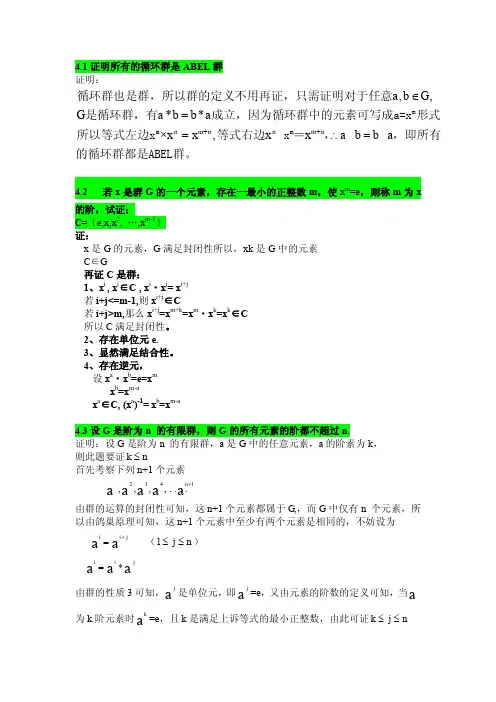
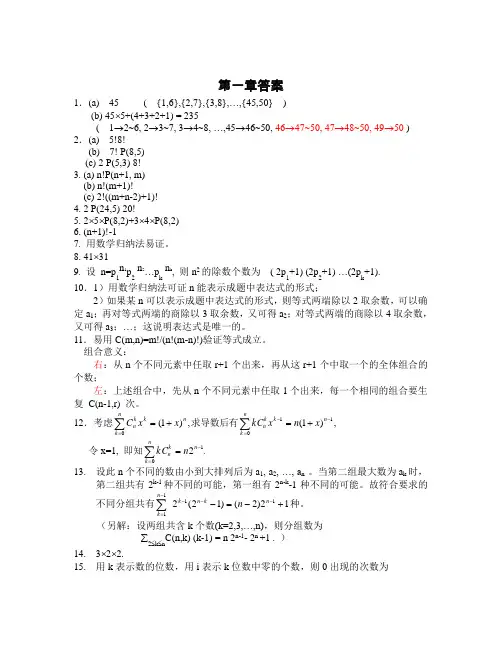
第一章答案1.(a) 45 ( {1,6},{2,7},{3,8},…,{45,50} )(b) 45⨯5+(4+3+2+1) = 235( 1→2~6, 2→3~7, 3→4~8, …,45→46~50, 46→47~50, 47→48~50, 49→50 ) 2.(a) 5!8!(b) 7! P(8,5) (c) 2 P(5,3) 8! 3. (a) n!P(n+1, m) (b) n!(m+1)!(c) 2!((m+n-2)+1)! 4. 2 P(24,5) 20!5. 2⨯5⨯P(8,2)+3⨯4⨯P(8,2)6. (n+1)!-17. 用数学归纳法易证。
8. 41⨯319. 设 n=p 1n 1p 2n 2…p kn k , 则n 2的除数个数为 ( 2p 1+1) (2p 2+1) …(2p k+1).10.1)用数学归纳法可证n 能表示成题中表达式的形式;2)如果某n 可以表示成题中表达式的形式,则等式两端除以2取余数,可以确定a 1;再对等式两端的商除以3取余数,又可得a 2;对等式两端的商除以4取余数,又可得a 3;…;这说明表达式是唯一的。
11.易用C(m,n)=m!/(n!(m-n)!)验证等式成立。
组合意义:右:从n 个不同元素中任取r+1个出来,再从这r+1个中取一个的全体组合的个数;左:上述组合中,先从n 个不同元素中任取1个出来,每一个相同的组合要生复 C(n-1,r) 次。
12.考虑,)1(,)1(101-=-=+=+=∑∑n nk k k n nnk kknx n x kC x x C 求导数后有令x=1, 即知.210-==∑n nk kn n kC13. 设此n 个不同的数由小到大排列后为a 1, a 2, …, a n 。
当第二组最大数为a k 时,第二组共有2k-1种不同的可能,第一组有2n-k -1种不同的可能。
故符合要求的不同分组共有12)2()12(21111+-=-----=∑n k n k n k n 种。
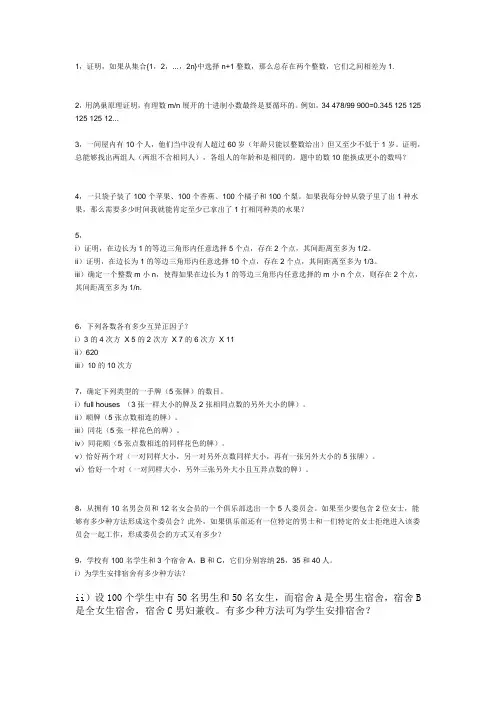
1,证明,如果从集合{1,2,...,2n}中选择n+1整数,那么总存在两个整数,它们之间相差为1.2,用鸽巢原理证明,有理数m/n展开的十进制小数最终是要循环的。
例如,34 478/99 900=0.345 125 125 125 125 12...3,一间屋内有10个人,他们当中没有人超过60岁(年龄只能以整数给出)但又至少不低于1岁。
证明,总能够找出两组人(两组不含相同人),各组人的年龄和是相同的。
题中的数10能换成更小的数吗?4,一只袋子装了100个苹果、100个香蕉、100个橘子和100个梨。
如果我每分钟从袋子里了出1种水果,那么需要多少时间我就能肯定至少已拿出了1打相同种类的水果?5,i)证明,在边长为1的等边三角形内任意选择5个点,存在2个点,其间距离至多为1/2。
ii)证明,在边长为1的等边三角形内任意选择10个点,存在2个点,其间距离至多为1/3。
iii)确定一个整数m小n,使得如果在边长为1的等边三角形内任意选择的m小n个点,则存在2个点,其间距离至多为1/n.6,下列各数各有多少互异正因子?i)3的4次方X 5的2次方X 7的6次方X 11ii)620iii)10的10次方7,确定下列类型的一手牌(5张牌)的数目。
i)full houses (3张一样大小的牌及2张相同点数的另外大小的牌)。
ii)顺牌(5张点数相连的牌)。
iii)同花(5张一样花色的牌)。
iv)同花顺(5张点数相连的同样花色的牌)。
v)恰好两个对(一对同样大小,另一对另外点数同样大小,再有一张另外大小的5张牌)。
vi)恰好一个对(一对同样大小,另外三张另外大小且互异点数的牌)。
8,从拥有10名男会员和12名女会员的一个俱乐部选出一个5人委员会。
如果至少要包含2位女士,能够有多少种方法形成这个委员会?此外,如果俱乐部还有一位特定的男士和一们特定的女士拒绝进入该委员会一起工作,形成委员会的方式又有多少?9,学校有100名学生和3个宿舍A,B和C,它们分别容纳25,35和40人。
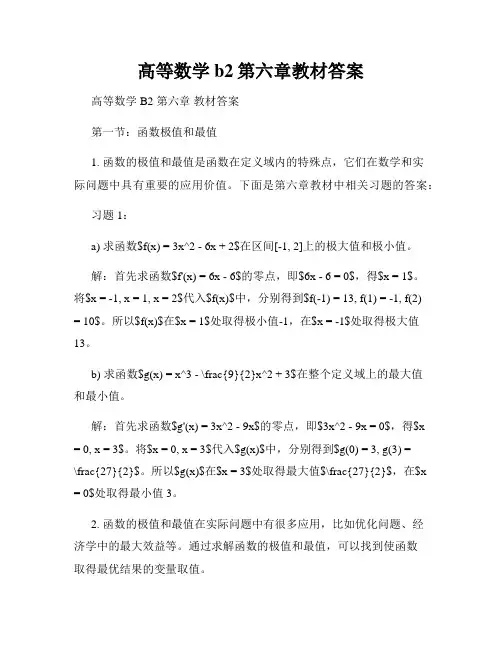
高等数学b2第六章教材答案高等数学B2 第六章教材答案第一节:函数极值和最值1. 函数的极值和最值是函数在定义域内的特殊点,它们在数学和实际问题中具有重要的应用价值。
下面是第六章教材中相关习题的答案:习题1:a) 求函数$f(x) = 3x^2 - 6x + 2$在区间[-1, 2]上的极大值和极小值。
解:首先求函数$f'(x) = 6x - 6$的零点,即$6x - 6 = 0$,得$x = 1$。
将$x = -1, x = 1, x = 2$代入$f(x)$中,分别得到$f(-1) = 13, f(1) = -1, f(2)= 10$。
所以$f(x)$在$x = 1$处取得极小值-1,在$x = -1$处取得极大值13。
b) 求函数$g(x) = x^3 - \frac{9}{2}x^2 + 3$在整个定义域上的最大值和最小值。
解:首先求函数$g'(x) = 3x^2 - 9x$的零点,即$3x^2 - 9x = 0$,得$x = 0, x = 3$。
将$x = 0, x = 3$代入$g(x)$中,分别得到$g(0) = 3, g(3) =\frac{27}{2}$。
所以$g(x)$在$x = 3$处取得最大值$\frac{27}{2}$,在$x = 0$处取得最小值3。
2. 函数的极值和最值在实际问题中有很多应用,比如优化问题、经济学中的最大效益等。
通过求解函数的极值和最值,可以找到使函数取得最优结果的变量取值。
习题2:一块长方形的地面上,以其一条边为底,作一个等腰直角梯形,使得梯形的上底与下底分别与已知两块木板的宽度相等。
问该等腰直角梯形的底边长度为多少,才能使梯形的面积最大。
解:设等腰直角梯形的底边长度为$x$,则梯形的上底和下底长度也都为$x$。
设梯形的高为$h$,根据勾股定理得到$h = \sqrt{2}x$。
梯形的面积$S(x) = \frac{1}{2}(x + x)(\sqrt{2}x)$。
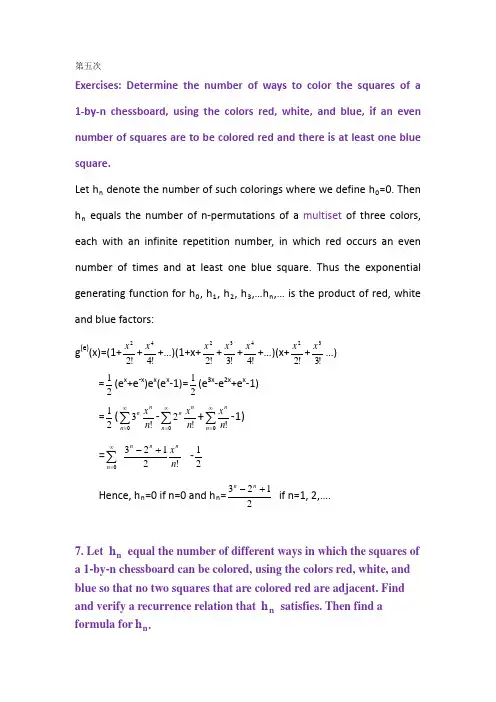
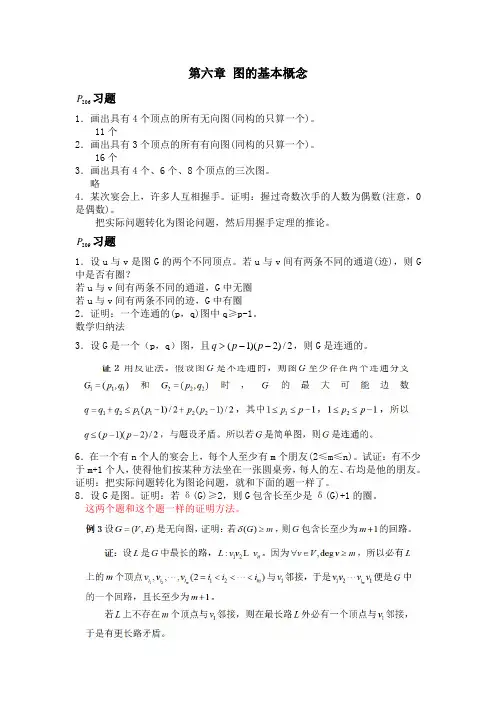
第六章图的基本概念P习题2061.画出具有4个顶点的所有无向图(同构的只算一个)。
11个2.画出具有3个顶点的所有有向图(同构的只算一个)。
16个3.画出具有4个、6个、8个顶点的三次图。
略4.某次宴会上,许多人互相握手。
证明:握过奇数次手的人数为偶数(注意,0是偶数)。
把实际问题转化为图论问题,然后用握手定理的推论。
P习题2091.设u与v是图G的两个不同顶点。
若u与v间有两条不同的通道(迹),则G 中是否有圈?若u与v间有两条不同的通道,G中无圈若u与v间有两条不同的迹,G中有圈2.证明:一个连通的(p,q)图中q≥p-1。
数学归纳法3.设G是一个(p,q)图,且2/)2>p-q,则G是连通的。
p)(1(-6.在一个有n个人的宴会上,每个人至少有m个朋友(2≤m≤n)。
试证:有不少于m+1个人,使得他们按某种方法坐在一张圆桌旁,每人的左、右均是他的朋友。
证明:把实际问题转化为图论问题,就和下面的题一样了。
8.设G是图。
证明:若δ(G)≥2,则G包含长至少是δ(G)+1的圈。
这两个题和这个题一样的证明方法。
P习题2161.证明:若图G不是连通图,则G c 是连通图。
2.证明:每一个自补图有4n或4n+1个顶点。
P习题2281.给出一个10个顶点的非哈密顿图的例子,使得每一对不邻接的顶点u和v,均有:degu+degv≥9。
下图中任意一对不邻接的顶点u和v,均有:degu+degv≥9。
2.试求Kp中不同的哈密顿圈的个数。
(p-1)!/24.完全偶图Km,n为哈密顿图的充分必要条件是什么?10.证明具有奇数顶点的偶图不是哈密顿图。
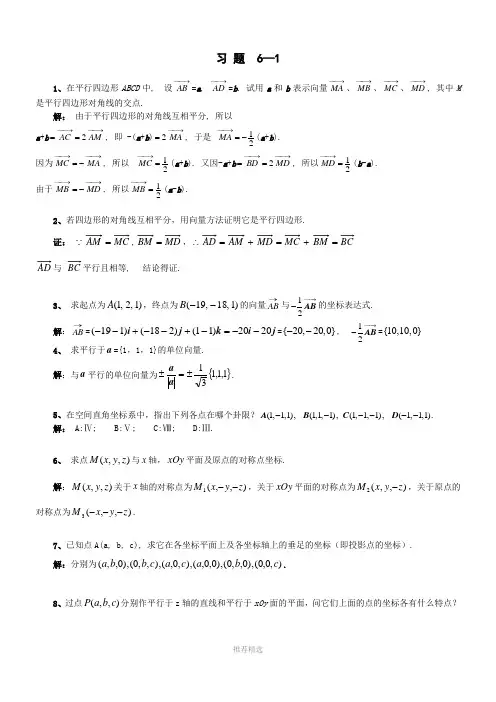
习 题 6—11、在平行四边形ABCD 中, 设−→−AB =a , −→−AD =b . 试用a 和b 表示向量−→−MA 、−→−MB 、−→−MC 、−→−MD , 其中M 是平行四边形对角线的交点.解: 由于平行四边形的对角线互相平分, 所以a +b −→−−→−==AM AC 2, 即 -(a +b )−→−=MA 2, 于是 21-=−→−MA (a +b ).因为−→−−→−-=MA MC , 所以21=−→−MC (a +b ). 又因-a +b −→−−→−==MD BD 2, 所以21=−→−MD (b -a ). 由于−→−−→−-=MD MB , 所以21=−→−MB (a -b ).2、若四边形的对角线互相平分,用向量方法证明它是平行四边形.证: =,BM =,∴=+=+BM =与 平行且相等,结论得证.3、 求起点为)1,2,1(A ,终点为)1,18,19(--B 的向量→AB 与12AB −−→-的坐标表达式.解:→AB =j i k j i 2020)11()218()119(--=-+--+--={20,20,0}--, 12AB −−→-={10,10,0}4、 求平行于a ={1,1,1}的单位向量.解:与a 平行的单位向量为{}1,1,131±=±a a .5、在空间直角坐标系中,指出下列各点在哪个卦限?(1,1,1),A - (1,1,1),B -(1,1,1),C -- (1,1,1).D -- 解: A:Ⅳ; B:Ⅴ; C:Ⅷ; D:Ⅲ.6、 求点),,(z y x M 与x 轴,xOy 平面及原点的对称点坐标.解:),,(z y x M 关于x 轴的对称点为),,(1z y x M --,关于xOy 平面的对称点为),,(2z y x M -,关于原点的对称点为),,(3z y x M ---.7、已知点A(a, b, c), 求它在各坐标平面上及各坐标轴上的垂足的坐标(即投影点的坐标). 解:分别为),0,0(),0,,0(),0,0,(),,0,(),,,0(),0,,(c b a c a c b b a .8、过点(,,)P a b c 分别作平行于z 轴的直线和平行于xOy 面的平面,问它们上面的点的坐标各有什么特点?解:平行于z 轴的直线上面的点的坐标:x a,y b,z R ==∈;平行于xOy 面的平面上的点的坐标为 z c,x,y R =∈.9、求点P (2,-5,4)到原点、各坐标轴和各坐标面的距离.解:到原点的距离为x y 轴的距离为到z10、 求证以)1,3,4(1M 、)2,1,7(2M 、)3,2,5(3M 三点为顶点的三角形是一个等腰三角形. 解:222212(74)(13)(21)14M M =-+-+-=,222223(57)(21)(32)6M M =-+-+-= 222213(45)(32)(13)6M M =-+-+-=,即1323M M M M =,因此结论成立.11、 在yoz 坐标面上,求与三个点A(3, 1, 2), B(4, -2, -2), C(0, 5, 1)等距离的点的坐标. 解:设yoz 坐标面所求点为),,0(z y M ,依题意有||||||MC MB MA ==,从而222)2()1()30(-+-+-z y 222)2()2()40(++++-=z y222)2()1()30(-+-+-z y联立解得2,1-==z y ,故所求点的坐标为)2,1,0(-.12、 z 轴上,求与点A(-4, 1, 7), 点B(3, 5,-2)等距离的点. 解:设所求z 轴上的点为),0,0(z ,依题意:222)7()10()40(-+-++z 222)2()50()30(++-+-=z ,两边平方得914=z ,故所求点为)914,0,0(.13、 求λ使向量}5,1,{λ=a 与向量}50,10,2{=b 平行. 解:由b a //得5051012==λ得51=λ.14、 求与y 轴反向,模为10的向量a 的坐标表达式. 解:a =j j 10)(10-=-⋅={0,10,0}-.15、求与向量a ={1,5,6}平行,模为10的向量b 的坐标表达式. 解:}6,5,1{6210==a a a ,故 {}6,5,16210100±=±=a b .16、 已知向量6410=-+a i j k ,349=+-b i j k ,试求: (1)2+a b ; (2)32-a b .解:(1) 264102(349)1248i a b i j k i j k j k +=-+++-=+-; (2)323(6410)2(349)=122048a b =i j k i j k i j k --+-+--+.17、已知两点A 和(3,0,4)B ,求向量AB 的模、方向余弦和方向角.解: 因为(1,1)AB =-, 所以2AB =,11cos ,cos 22αβγ===-,从而π3α=,3π4β=,2π3γ=.18、设向量的方向角为α、β、γ.若已知其中的两个角为π3α=,2π3β=.求第三个角γ. 解: π3α=,2π3β=,由222cos cos cos 1αβγ++=得21cos 2γ=.故π4γ=或3π4.19、 已知三点(1,0,0)=A ,(3,1,1)B ,(2,0,1)C ,求:(1)BC 与CA 及其模;(2)BC 的方向余弦、方向角;(3)与BC 同向的单位向量.解:(1)由题意知{}{}23,01,111,1,0,BC =---=--{}{}12,00,011,0,1,CA =---=-- 故 2,2==BC CA .(2)因为{}1,1,0,=--BC 所以,由向量的方向余弦的坐标表示式得:cos 0αβγ===,方向角为:3,42ππαβγ===.(3)与BC 同向的单位向量为:oa =⎧⎫=⎨⎬⎩⎭BCBC .20、 设23,23,34,m i j k n i j k p i j k =++=+-=-+和23a m n p =+-求向量在x 轴上的投影和在y 轴上的分向量.解:2(23)3(23)(34)5114a i j k i j k i j k i j k =++++---+=+-.故向量a 在x 轴上的投影5=x a ,在y 轴上的投影分量为11y a j =.21、一向量的终点为点B(-2,1,-4),它在x 轴,y 轴和z 轴上的投影依次为3,-3和8,求这向量起点A 的坐标.解:设点A 为(x, y, z ),依题意有:84,31,32=---=-=--z y x , 故12,4,5-==-=z y x ,即所求的点A (-5, 4,-12).22、 已知向量a 的两个方向余弦为cos α=72 ,cos β=73, 且a 与z 轴的方向角是钝角.求cos γ. 解:因222cos cos cos 1,αβγ++=22223366cos 1cos 77497γγ=-==±故()—(),,又γ是钝角,所以76cos -=γ.23、设三力1232234F ,F ,F i j i j k j k =-=-+=+作用于同一质点,求合力的大小和方向角.解: 合力123(2)(234)()F F F F i k i j k j k =++=-+-+++323i j k =-+,因此,合力的大小为|F |=合力的方向余弦为,222cos ,cos 223cos -===βγα因此παγβ===-习 题 6—21、 {}0,0,1=a ,{}0,1,0=b ,)1,0,0(=c ,求⋅a b ,c a ⋅,c b ⋅,及a a ⨯,b a ⨯,c a ⨯,c b ⨯. 解:依题意,i a =,j b =,k c =,故0=⋅=⋅j i b a ,0=⋅=⋅k i c a ,0=⋅=⋅k j c b .0=⨯=⨯i i a a ,k j i b a =⨯=⨯,j k i c a -=⨯=⨯,i k j c b =⨯=⨯.2、 }}{{1,2,2,21,1==b a ,,求b a ⋅及b a ⨯ .a 与b的夹角余弦. 解:(1)121221⋅=⨯+⨯+⨯=a b 6, 112221⨯==i j ka b }{3,3,0-.(2)cos a b a b a b θ++==3、 已知 π5,2,,3∧⎛⎫=== ⎪⎝⎭a b a b ,求23a b -解:()()2232323-=-⋅-a b a b a b 22412976=-⋅+=a a b b ,∴ 23-=ab4、 证明下列问题:1)证明向量}{1,0,1=a 与向量}{1,1,1-=b 垂直. 2) 证明向量c 与向量()()a c b b c a ⋅-⋅垂直. 证:1)01110)1(1=⨯+⨯+-⨯=⋅b a ,^π(,)2a b ∴=,即a 与b 垂直. 2) [()()]⋅-⋅⋅a c b b c a c [()()]=⋅⋅-⋅⋅a c b c b c a c ()[]=⋅⋅-⋅c b a c a c 0=[()()]∴⋅-⋅⊥a c b b c a c .5、 求点)1,2,1(M 的向径OM 与坐标轴之间的夹角.解:设OM 与x 、y 、z 轴之间的夹角分别为γβα,,,则211)2(11cos 22=++==α,22cos ==β, 21cos ==γ. 3π=∴α, 4π=β, 3π=γ.6、 求与k j i a ++=平行且满足1=⋅x a 的向量x .解:因x a //, 故可设{}λλλλ,,==a x ,再由1=⋅x a 得1=++λλλ,即31=λ,从而⎭⎬⎫⎩⎨⎧=31,31,31x .7、求与向量324=-+a i j k ,2=+-b i j k 都垂直的单位向量.解:=⨯=xy z x y zij kc a b a a a b b b 324112=--i j k =105+j k,||10==c 0||∴=c c c=.⎫±+⎪⎭j8、 在顶点为)2,1,1(-A 、)2,6,5(-B 和)1,3,1(-C 的三角形中,求三角形ABC 的面积以及AC 边上的高BD .解:{0,4,3},{4,5,0}AC AB =-=-,三角形ABC 的面积为,22516121521||21222=++=⨯=AB C A S ||||21,5)3(4||22BD S ==-+= ||521225BD ⋅⋅= .5||=∴BD9、 已知向量≠0a ,≠0b ,证明2222||||||()⨯=-⋅a b a b a b .解 2222||||||sin ()∧⨯=⋅a b a b ab 222||||[1cos ()]∧=⋅-a b ab 22||||=⋅a b 222||||cos ()∧-⋅a b ab 22||||=⋅a b 2().-⋅a b10、 证明:如果++=0a b c ,那么⨯=⨯=⨯b c c a a b ,并说明它的几何意义.证: 由++=0a b c , 有()++⨯=⨯=00a b c c c , 但⨯=0c c ,于是⨯+⨯=0a c b c ,所以⨯=-⨯=⨯b c a c c a . 同理 由()++⨯=0a b c a , 有 ⨯=⨯c a a b ,从而 ⨯=⨯=⨯b c c a a b .其几何意义是以三角形的任二边为邻边构成的平行四边形的面积相等.11、 已知向量23,3=-+=-+a i j k b i j k 和2=-c i j ,计算下列各式:(1)()()⋅-⋅a b c a c b (2)()()+⨯+a b b c (3)()⨯⋅a b c (4)⨯⨯a b c 解: (1)()()8(2)8(3)⋅-⋅=---+=a b c a c b i j i j k 824--j k .(2) 344,233+=-++=-+a b i j k b c i j k ,故()()+⨯+a b b c 344233=-=-i jk--j k . (3)231()231(2)(85)(2)11311312-⨯⋅=-⋅-=--+⋅-=-=--i jk a b c i j i j k i j 2. (4)由(3)知85,()851120⨯=--+⨯⨯=--=-i jka b i j k a b c 221++i j k .习 题 6—31、已知)3,2,1(A ,)4,1,2(-B ,求线段AB 的垂直平分面的方程. 解:设),,(z y x M 是所求平面上任一点,据题意有|,|||MB MA =()()()222321-+-+-z y x ()()(),412222-+++-=z y x化简得所求方程26270x y z -+-=.这就是所求平面上的点的坐标所满足的方程, 而不在此平面上的点的坐标都不满足这个方程,所以这个方程就是所求平面的方程.2、 一动点移动时,与)0,0,4(A 及xOy 平面等距离,求该动点的轨迹方程.解:设在给定的坐标系下,动点),,(z y x M ,所求的轨迹为C ,则(,,)M x y z C MA z ∈⇔= 亦即z z y x =++-222)4( 0)4(22=+-∴y x 从而所求的轨迹方程为0)4(22=+-y x .3、 求下列各球面的方程:(1)圆心)3,1,2(-,半径为6=R ; (2)圆心在原点,且经过点)3,2,6(-;(3)一条直径的两端点是)3,1,4()5,32(--与;(4)通过原点与)4,0,0(),0,3,1(),0,0,4(- 解:(1)所求的球面方程为:36)3()1()2(222=-+++-z y x (2)由已知,半径73)2(6222=+-+=R ,所以球面方程为49222=++z y x(3)由已知,球面的球心坐标1235,1213,3242=-=-=+-==+=c b a , 球的半径21)35()31()24(21222=++++-=R ,所以球面方程为: 21)1()1()3(222=-+++-z y x(4)设所求的球面方程为:0222222=++++++l kz hy gx z y x因该球面经过点)4,0,0(),0,3,1(),0,0,4(),0,0,0(-,所以⎪⎪⎩⎪⎪⎨⎧=-=++=+=08160621008160k h g g l 解之得⎪⎪⎩⎪⎪⎨⎧=-=-==2210k g h l∴所求的球面方程为0424222=+--++z y x z y x .4、将yOz 坐标面上的抛物线22y z =绕z 旋转一周,求所生成的旋转曲面的方程. 解:222x y z +=(旋转抛物面) .5、将zOx 坐标面上的双曲线12222=-c z a x 分别绕x 轴和z 轴旋转一周,求所生成的旋转曲面的方程.解: 绕x 轴旋转得122222=+-c z y a x 绕z 轴旋转得122222=-+cz a y x .6、指出下列曲面的名称,并作图:(1)22149x z +=;(2)22y z =;(3)221x z += ;(4)22220x y z x ++-=; (5)222y x z +=;(6)22441x y z -+=;(7)221916x y z ++=;(8)222149x y z -+=-;(9)1334222=++z y x ;(10)2223122z y x +=+.解: (1)椭圆柱面;(2) 抛物柱面;(3) 圆柱面;(4)球面;(5)圆锥面;(6)双曲抛物面;(7)椭圆抛物面;(8)双叶双曲面;(9)为旋转椭球面;(10)单叶双曲面.7、指出下列方程在平面解析几何和空间解析几何中分别表示什么图形? (1)1+=x y ;(2)422=+yx ;(3)122=-y x ;(4)22x y =.解:(1)1+=x y 在平面解析几何中表示直线,在空间解析几何中表示平面; (2)422=+y x 在平面解析几何中表示圆周,在空间解析几何中表示圆柱面; (3)122=-y x 在平面解析几何中表示双曲线,在空间解析几何中表示双曲柱面;(4)y x22=在平面解析几何中表示抛物线,在空间解析几何中表示抛物柱面.8、 说明下列旋转曲面是怎样形成的?(1)1994222=++z y x ;(2)14222=+-z y x (3)1222=--z y x ;(4)222)(y x a z +=- 解:(1)xOy 平面上椭圆19422=+y x 绕x 轴旋转而成;或者 xOz 平面上椭圆22149+=x z 绕x 轴旋转而成(2)xOy 平面上的双曲线1422=-y x 绕y 轴旋转而成;或者 yOz 平面上的双曲线2214-=y z 绕y 轴旋转而成(3)xOy 平面上的双曲线122=-y x 绕x 轴旋转而成;或者 xOz 平面上的双曲线221x z -=绕x 轴旋转而成 (4)yOz 平面上的直线a y z +=绕z 轴旋转而成或者 xOz 平面上的直线z x a =+绕z 轴旋转而成.9、 画出下列各曲面所围立体的图形:(1)012243=-++z y x 与三个坐标平面所围成;(2)42,42=+-=y x x z 及三坐标平面所围成; (3)22=0,(0)=1z z =a a >,y =x,x +y 及0x =在第一卦限所围成;(4)2222,8z x y z x y =+=--所围. 解:(1)平面012243=-++z y x 与三个坐标平面围成一个在第一卦限的四面体; (2)抛物柱面24z x =-与平面24x y +=及三坐标平面所围成;(3)坐标面=0z 、0x =及平面(0)z =a a >、y=x 和圆柱面22=1x +y 在第一卦限所围成; (4)开口向上的旋转抛物面22z x y =+与开口向下的抛物面228z x y =--所围.作图略.习 题 6—41、画出下列曲线在第一卦限内的图形(1)⎩⎨⎧==21y x ;(2)⎪⎩⎪⎨⎧=---=0422y x y x z ;(3)⎪⎩⎪⎨⎧=+=+222222a z x ay x解:(1)是平面1x =与2y =相交所得的一条直线; (2)上半球面z 与平面0x y -=的交线为14圆弧; (3)圆柱面222x y a +=与222x z a +=的交线.图形略.2、分别求母线平行于x 轴及y 轴而且通过曲线⎪⎩⎪⎨⎧=-+=++0162222222y z x z y x 的柱面方程.解:消去x 坐标得16322=-z y ,为母线平行于x 轴的柱面;消去y 坐标得:162322=+z x ,为母线平行于y 轴的柱面.3、求在yOz 平面内以坐标原点为圆心的单位圆的方程(任写出三种不同形式的方程).解:⎩⎨⎧==+0122x z y ;⎩⎨⎧==++01222x z y x ; ⎪⎩⎪⎨⎧=+=++1122222z y z y x .4、试求平面20x -=与椭球面222116124x y z ++=相交所得椭圆的半轴与顶点.解:将椭圆方程22211612420x y z x ⎧++=⎪⎨⎪-=⎩化简为:221932y z x ⎧+=⎪⎨⎪=⎩,可知其为平面2=x 上的椭圆,半轴分别为3,3,顶点分别为)3,0,2(),3,0,2(),0,3,2(),0,3,2(--.5 、将下面曲线的一般方程化为参数方程(1)2229x y z y x ⎧++=⎨=⎩; (2)⎩⎨⎧==+++-04)1()1(22z z y x解:(1)原曲线方程即:⎪⎩⎪⎨⎧=+=199222z x xy ,化为⎪⎪⎪⎩⎪⎪⎪⎨⎧=≤≤==tz t t y t x sin 3)20(cos 23cos 23π;(2))20(0sin 3cos 31πθθθ≤≤⎪⎪⎩⎪⎪⎨⎧==+=z y x .6、求螺旋线⎪⎩⎪⎨⎧===θθθb z a y a x sin cos 在三个坐标面上的投影曲线的直角坐标方程.解:⎩⎨⎧==+0222z a y x ;⎪⎩⎪⎨⎧==0sin x b z a y ;⎪⎩⎪⎨⎧==0cosy b z a x .7、指出下列方程所表示的曲线(1)222253⎧++=⎨=⎩x y z x (2)⎩⎨⎧==++13094222z z y x ;(3)⎩⎨⎧-==+-3254222x z y x ; (4)⎩⎨⎧==+-+408422y x z y ; (5)⎪⎩⎪⎨⎧=-=-0214922x z y . 解:(1)圆; (2)椭圆; (3)双曲线; (4)抛物线; (5)双曲线.8、 求曲线⎩⎨⎧==-+30222z x z y 在xOy 面上的投影曲线方程,并指出原曲线是何种曲线.解:原曲线即:⎩⎨⎧=-=3922z x y ,是位于平面3=z 上的抛物线,在xOy 面上的投影曲线为⎩⎨⎧=-=0922z x y9、 求曲线 ⎪⎩⎪⎨⎧==++211222z z y x 在坐标面上的投影. 解:(1)消去变量z 后得,4322=+y x 在xOy 面上的投影为,04322⎪⎩⎪⎨⎧==+z y x 它是中心在原点,半径为23的圆周.(2)因为曲线在平面21=z 上,所以在xOz 面上的投影为线段.;23||,021≤⎪⎩⎪⎨⎧==x y z (3)同理在yOz 面上的投影也为线段..23||,21≤⎪⎩⎪⎨⎧==y x z10、 求抛物面x z y =+22与平面 02=-+z y x 的交线在三个坐标面上的投影曲线方程.解: 交线方程为⎩⎨⎧=-+=+0222z y x x z y ,(1)消去z 得投影,004522⎩⎨⎧==-++z x xy y x(2)消去y 得投影2252400x z xz x y ⎧+--=⎨=⎩,(3)消去x 得投影22200y z y z x ⎧++-=⎨=⎩.习 题 6—51、写出过点()3,2,10M 且以{}1,2,2=n 为法向量的平面方程. 解:平面的点法式方程为()()()032212=-+-+-z y x .2、求过三点()()()01,0,0,1,0,0,0,1C B A 的平面方程.解:设所求平面方程为0=+++d cz by ax ,将C B A ,,的坐标代入方程,可得d c b a -===,故所求平面方程为1=++z y x .3、求过点()1,0,0且与平面1243=++z y x 平行的平面方程. 解:依题意可取所求平面的法向量为}2,4,3{=n ,从而其方程为()()()0120403=-+-+-z y x 即 2243=++z y x .4、求通过x 轴和点(4, -3, -1)的平面的方程.解:平面通过x 轴, 一方面表明它的法线向量垂直于x 轴, 即A =0; 另一方面表明它必通过原点, 即D =0. 因此可设这平面的方程为By +Cz =0.又因为这平面通过点(4, -3, -1), 所以有-3B -C =0, 或C =-3B . 将其代入所设方程并除以B (B 0), 便得所求的平面方程为y -3z =0.5、求过点)1,1,1(,且垂直于平面7=+-z y x 和051223=+-+z y x 的平面方程.解:},1,1,1{1-=n }12,2,3{2-=n 取法向量},5,15,10{21=⨯=n n n所求平面方程为化简得:.0632=-++z y x6、设平面过原点及点)1,1,1(,且与平面8x y z -+=垂直,求此平面方程.解: 设所求平面为,0=+++D Cz By Ax 由平面过点)1,1,1(知平0,A B C D +++=由平面过原点知0D =,{1,1,1},n ⊥- 0A B C ∴-+=,0A C B ⇒=-=,所求平面方程为0.x z -=7、写出下列平面方程:(1)xOy 平面;(2)过z 轴的平面;(3)平行于zOx 的平面;(4)在x ,y ,z 轴上的截距相等的平面.解:(1)0=z ,(2)0=+by ax (b a ,为不等于零的常数), (3)c y = (c 为常数), (4) a z y x =++ (0)a ≠.8、 求平行于0566=+++z y x 而与三个坐标面所围成的四面体体积为1的平面方程.解: 设平面为,1=++c z b y a x ,1=V 111,32abc ∴⋅=由所求平面与已知平面平行得,611161c b a ==化简得,61161c b a ==令tc t b t a t c b a 61,1,6161161===⇒===代入体积式 11111666t t t ∴=⋅⋅⋅ 1,6t ⇒=±,1,6,1===∴c b a 或1,6,1,a b c =-=-=-所求平面方程为666x y z ++=或666x y z ++=-.9、分别在下列条件下确定n m l ,,的值:(1)使08)3()1()3(=+-+++-z n y m x l 和016)3()9()3(=--+-++z l y n x m 表示同一平面; (2)使0532=-++z my x 与0266=+--z y lx 表示二平行平面; (3)使013=+-+z y lx 与027=-+z y x 表示二互相垂直的平面.解:(1)欲使所给的二方程表示同一平面,则:168339133-=--=-+=+-l n n m m l 即: ⎪⎩⎪⎨⎧=-+=-+=-+092072032n l m n l m ,解之得 97=l ,913=m ,937=n . (2)欲使所给的二方程表示二平行平面,则:6362-=-=m l ,所以4-=l ,3=m . (3)欲使所给的二方程表示二垂直平面,则:7230l ++=所以: 57l=-.10、求平面011=-+y x 与083=+x 的夹角; 解:设011=-+y x 与083=+x 的夹角为θ,则cos θ ∴ 4πθ=.11、 求点(2,1,1)到平面2240x y z +-+=的距离. 解:利用点到平面的距离公式可得933d ===.习 题 6—61、求下列各直线的方程:(1)通过点)1,0,3(-A 和点)1,5,2(-B 的直线; (2) 过点()1,1,1且与直线433221-=-=-z y x 平行的直线. (3)通过点)3,51(-M 且与z y x ,,三轴分别成︒︒︒120,45,60的直线; (4)一直线过点(2,3,4)-A ,且和y 轴垂直相交,求其方程. (5)通过点)2,0,1(-M 且与两直线11111-+==-z y x 和01111+=--=z y x 垂直的直线; (6)通过点)5,3,2(--M 且与平面02536=+--z y x 垂直的直线.解:(1)所求的直线方程为:015323-=-=++z y x 即:01553-=-=+z y x ,亦即01113-=-=+z y x . (2)依题意,可取L 的方向向量为{}4,3,2=s ,则直线L 的方程为413121-=-=-z y x . (3)所求直线的方向向量为:{}⎭⎬⎫⎩⎨⎧-=︒︒︒21,22,21120cos ,45cos ,60cos ,故直线方程为: 132511--=+=-z y x . (4)因为直线和y 轴垂直相交,所以交点为),0,3,0(-B 取{2,0,4},BA s −−→==所求直线方程.440322-=+=-z y x (5)所求直线的方向向量为:{}{}{}2,1,10,1,11,1,1---=-⨯-,所以,直线方程为:22111+==-z y x . (6)所求直线的方向向量为:{}5,3,6--,所以直线方程为: 235635x y z -++==--.2、求直线1,234x y z x y z ++=-⎧⎨-+=-⎩的点向式方程与参数方程.解 在直线上任取一点),,(000z y x ,取10=x ,063020000⎩⎨⎧=--=++⇒z y z y 解2,000-==z y .所求点的坐标为)2,0,1(-,取直线的方向向量{}{}3,1,21,1,1-⨯=s k j i kji34312111--=-=,所以直线的点向式方程为:,321041-+=--=-z y x 令102,413x y z t --+===--则所求参数方程: .3241⎪⎩⎪⎨⎧--=-=+=tz ty tx3、判别下列各对直线的相互位置,如果是相交的或平行的直线求出它们所在的平面,如果相交时请求出夹角的余弦.(1)⎩⎨⎧=-+=+-0623022y x z y x 与⎩⎨⎧=-+=--+01420112z x z y x ;(2)⎪⎩⎪⎨⎧--=+==212t z t y tx 与142475x y z --+==-. 解:(1)将所给的直线方程化为标准式为:4343223z y x =-=--43227-=--=-z y x 234234-==-- ∴二直线平行.又点)0,43,23(与点(7,2,0)在二直线上,∴向量⎭⎬⎫⎩⎨⎧=⎭⎬⎫⎩⎨⎧--0,45,2110,432,237平行于二直线所确定的平面,该平面的法向量为:{}{}19,22,50,45,2114,3,2--=⎭⎬⎫⎩⎨⎧⨯-,从而平面方程为:0)0(19)2(22)7(5=-+---z y x ,即0919225=++-z y x .(2)因为121475-≠≠-,所以两直线不平行,又因为0574121031=--=∆,所以两直线相交,二直线所决定的平面的法向量为{}{}{}1,1,35,7,412,1--=-⨯-,∴二直线所决定的平面的方程为:330x y z -++=.设两直线的夹角为ϕ,则cos ϕ==4、判别下列直线与平面的相关位置: (1)37423z y x =-+=--与3224=--z y x ;(2)723zy x =-=与8723=+-z y x ; (3)⎩⎨⎧=---=-+-01205235z y x z y x 与07734=-+-z y x ;(4)⎪⎩⎪⎨⎧-=+-==4992t z t y t x 与010743=-+-z y x .解(1) 0)2(3)2()7(4)2(=-⨯+-⨯-+⨯-,而017302)4(234≠=-⨯--⨯-⨯,所以,直线与平面平行.(2) 0717)2(233≠⨯+-⨯-⨯,所以,直线与平面相交,且因为772233=--=,∴直线与平面垂直. (3)直线的方向向量为:{}{}{}1,9,51,1,22,3,5=--⨯-, 0179354=⨯+⨯-⨯,所以直线与平面平行或者直线在平面上;取直线上的点)0,5,2(--M ,显然点在)0,5,2(--M 也在平面上(因为4(2)3(5)70⨯--⨯--=),所以,直线在平面上.(4)直线的方向向量为{}9,2,1-, 097)2(413≠⨯+-⨯-⨯∴直线与平面相交但不垂直.5、验证直线l :21111-=-=-z y x 与平面π:032=--+z y x 相交,并求出它的交点和交角. 解: 032111)1(2≠-=⨯-⨯+-⨯∴直线与平面相交.又直线的参数方程为:⎪⎩⎪⎨⎧+=+=-=t z t y tx 211设交点处对应的参数为0t ,∴03)21()1()(2000=-+-++-⨯t t t ∴10-=t ,从而交点为(1,0,-1). 又设直线l 与平面π的交角为θ,则:21662111)1(2sin =⨯⨯-⨯+-⨯=θ,∴6πθ=.6、确定m l ,的值,使: (1)直线13241zy x =+=-与平面0153=+-+z y lx 平行; (2)直线⎪⎩⎪⎨⎧-=--=+=135422t z t y t x 与平面076=-++z my lx 垂直.解:(1)欲使所给直线与平面平行,则须:015334=⨯-⨯+l 即1l =-. (2)欲使所给直线与平面垂直,则须:3642=-=m l ,所以:8,4-==m l .7、求下列各平面的方程: (1)通过点)1,0,2(-p ,且又通过直线32121-=-=+z y x 的平面; (2)通过直线115312-+=-+=-z y x 且与直线⎩⎨⎧=--+=---052032z y x z y x 平行的平面; (3)通过直线223221-=-+=-z y x 且与平面0523=--+z y x 垂直的平面;(4). 求过点(2,1,0)M 与直线2335x t y t z t =-⎧⎪=+⎨⎪=⎩垂直的平面方程.解:(1)因为所求的平面过点)1,0,2(-p 和)2,0,1(-'p ,且它平行于向量{}3,1,2-,所以要求的平面方程为:03331212=--+-z y x , 即015=-++z y x .(2)已知直线的方向向量为{}{}{}2,1,11,2,13,1,5--⨯-=,∴平面方程为:2311510315x y z -++--=,即3250x y z +--= (3)所求平面的法向量为{}{}{}13,8,11,2,32,3,2-=-⨯-,∴平面的方程为:0)2(13)2(8)1(=--+--z y x ,即09138=+--z y x .(4).所求平面的法向量为{}2,3,1,则平面的方程为:2(2)3(1)(0)0x y z -+-+-=, 即 2370x y z ++-=.8、求点(4,1,2)M 在平面1x y z ++=上的投影.解: 过点(4,1,2)M 作已知平面的垂线,垂线的方向向量就是已知平面的法向量(1,1,1),所以垂线方程为412111x y z ---==,此垂线与已知平面的交点即为所求投影.为了求投影,将垂线方程化为参数方程412x t y t z t =+⎧⎪=+⎨⎪=+⎩,代入平面方程求得2t =-,故投影为(2,1,0)-. 9、求点)1,3,2(-p 到直线⎩⎨⎧=++-=++-0172230322z y x z y x 的距离.解:直线的标准方程为:2251211-+==-z y x 所以p 到直线的距离 1534532025)2(1212392292421243222222===-++-+--+-=d .10、设0M 是直线L 外一点,M 是直线L 上一点,且直线的方向向量为s ,试证:点0M 到直线L 的距离为d =.证:设0M M 与L 的夹角为θ,一方面由于0sin d M M θ=;另一方面,00sin M M s M M s θ⨯=,所以d =.11、求通过平面0134=-+-z y x 和025=+-+z y x 的交线且满足下列条件之一的平面: (1)通过原点; (2)与y 轴平行;(3)与平面0352=-+-z y x 垂直. 解: (1)设所求的平面为:0)25()134(=+-++-+-z y x z y x λ 欲使平面通过原点,则须:021=+-λ,即21=λ,故所求的平面方程为 0)25()134(2=+-++-+-z y x z y x 即:0539=++z y x .(2)同(1)中所设,可求出51=λ.故所求的平面方程为 0)25()134(5=+-++-+-z y x z y x 即:031421=-+z x .(3)如(1)所设,欲使所求平面与平面0352=-+-z y x 垂直,则须:0)3(5)51()4(2=-++--+λλλ从而3=λ,所以所求平面方程为05147=++y x .12、求直线⎩⎨⎧=++-=--+0101z y x z y x 在平面0=++z y x 上的投影直线的方程.解:应用平面束的方法.设过直线⎩⎨⎧=++-=--+0101z y x z y x 的平面束方程为0)1()1(=++-+--+z y x z y x λ即01)1()1()1(=-++-+-++λλλλz y x这平面与已知平面0=++z y x 垂直的条件是01)1(1)1(1)1(=⋅+-+⋅-+⋅+λλλ,解之得1-=λ代入平面束方程中得投影平面方程为10y z --=,所以投影直线为⎩⎨⎧=++=--001z y x z y .13、请用异于本章第五节例7的方法来推导点到平面的距离公式.证:设),,(0000z y x P 是平面π:0+++=Ax By Cz D 外的一点,下面我们来求点0P 到平面π的距离. 过0P 作平面π的垂线L :000x x y y z z A B C---==,设L 与平面π的交点为(,,)P x y z ,则P 与0P 之间的距离即为所求.因为点(,,)P x y z 在L 上,所以000x x Aty y Bt z z Ct-=-=-=⎧⎪⎨⎪⎩,而(,,)P x y z 在平面π上,则000()()()0A x At B y Bt C z Ct D ++++++=000222Ax By Cz A B t DC ⇒=-+++++,故000222Ax By Cz Dd t A B C+++===++=.习 题 6—7飞机的速度:假设空气以每小时32公里的速度沿平行y 轴正向的方向流动,一架飞机在xoy 平面沿与x 轴正向成π6的方向飞行,若飞机相对于空气的速度是每小时840公里,问飞机相对于地面的速度是多少?解:如下图所示,设OA 为飞机相对于空气的速度,AB 为空气的流动速度,那么OB 就是飞机相对于地面的速度.840cos 840sin 4203420,3266OA i j i j AB j ππ=⋅+⋅=+=所以, 24203452,(420856.45OB i j OB =+=≈千米/小时.复习题A一 、判断正误:1、 若c b b a ⋅=⋅且≠0b ,则c a =; ( ⨯ )解析 c b b a ⋅-⋅=)(c a b -⋅=0时,不能判定=b 0或c a =.例如i a =,j b =,k c =,有⋅=⋅=0a b b c ,但c a ≠.2、 若c b b a ⨯=⨯且≠0b ,则c a =; ( ⨯ )解析 此结论不一定成立.例如i a =,j b =,)(j i c +-=,则k j i b a =⨯=⨯,k j i j c b =+-⨯=⨯)]([,c b b a ⨯=⨯,但c a ≠.3 、若0=⋅c a ,则=0a 或=0c ; ( ⨯ ) 解析 两个相互垂直的非零向量点积也为零.4、 a b b a ⨯-=⨯. ( √ ) 解析 这是叉积运算规律中的反交换律.二、选择题:1 、 当a 与b 满足( D )时,有b a b a +=+;(A)⊥a b ; (B)λ=a b (λ为常数); (C)a ∥b ; (D)⋅=a b a b .解析 只有当a 与b 方向相同时,才有a +b =a +b .(A)中a ,b 夹角不为0,(B),(C)中a ,b 方向可以相同,也可以相反.2、下列平面方程中,方程( C )过y 轴;图6-1 空所流动与飞机飞行速度的关系(A) 1=++z y x ; (B) 0=++z y x ; (C) 0=+z x ; (D) 1=+z x . 解析 平面方程0=+++D Cz By Ax 若过y 轴,则0==D B ,故选C .3 、在空间直角坐标系中,方程2221y x z --=所表示的曲面是( B );(A) 椭球面; (B) 椭圆抛物面; (C) 椭圆柱面; (D) 单叶双曲面.解析 对于曲面2221y x z --=,垂直于z 轴的平面截曲面是椭圆,垂直于x 轴或y 轴的平面截曲面是开口向下的抛物线,根据曲面的截痕法,可以判断曲面是椭圆抛物面.4、空间曲线⎩⎨⎧=-+=5,222z y x z 在xOy 面上的投影方程为( C );(A)722=+y x ; (B)⎩⎨⎧==+5722z y x ; (C) ⎩⎨⎧==+0722z y x ;(D)⎩⎨⎧=-+=0222z y x z解析 曲线⎩⎨⎧==+5722z y x 与xOy 平面平行,在xOy 面上的投影方程为⎩⎨⎧==+0722z y x .5 、直线11121-+==-z y x 与平面1=+-z y x 的位置关系是( B ). (A) 垂直; (B) 平行; (C) 夹角为π4; (D) 夹角为π4-.解析 直线的方向向量s ={2,1,-1},平面的法向量n ={1,-1,1},n s ⋅=2-1-1=0,所以,s ⊥n ,直线与平面平行.三、填空题:1、若2=b a ,π()2=a,b ,则=⨯b a 2 ,=⋅b a 0 ; 解 =⨯b a b a sin()a,b π22=2,=⋅b a b a cos()a,b π22=0.2、与平面062=-+-z y x 垂直的单位向量为 }2,1,1{66-±; 解 平面的法向量 n ={1,-1,2}与平面垂直,其单位向量为0n =411++=6,所以,与平面垂直的单位向量为}2,1,1{66-±.3、过点)2,1,3(--和)5,0,3(且平行于x 轴的平面方程为 057=-+z y ;解 已知平面平行于x 轴,则平面方程可设为 0=++D Cz By ,将点 (-3,1,-2)和(3,0,5)代入方程,有{20,50,B C D C D -+=+= ⇒ 7,51,5B D C D ⎧=-⎪⎨⎪=-⎩得 05157=+--D Dz Dy ,即 057=-+z y .4、过原点且垂直于平面022=+-z y 的直线为z yx -==20; 解 直线与平面垂直,则与平面的法向量 n ={0,2,-1}平行,取直线方向向量s =n ={0,2,-1},由于直线过原点,所以直线方程为z yx -==20 .5、曲线⎩⎨⎧=+=1,222z y x z 在xOy 平面上的投影曲线方程为 ⎩⎨⎧==+.0,1222z y x解: 投影柱面为 1222=+y x ,故 ⎩⎨⎧==+0,1222z y x 为空间曲线在xOy 平面上的投影曲线方程.四、解答题:1、 已知}1,2,1{-=a ,}2,1,1{=b ,计算(a) b a ⨯; (b) ()()-⋅+2a b a b ; (c) 2b a -;解: (a) b a ⨯=211121-kj i 1,3}5,{--=. (b) {2,4,2}{1,1,2}{1,5,0}2a b -=--=-,1,3}{2,{1,1,2}2,1}{1,-=+-=+b a , 所以()()-⋅+2a b a b 7}3,1,2{}0,5,1{=-⋅-=.(c) 1}3,{0,{1,1,2}2,1}{1,--=--=-b a ,所以2b a -10)19(2=+=.2、已知向量21P P 的始点为)5,2,2(1-P ,终点为)7,4,1(2-P ,试求:(1)向量21P P 的坐标表示; (2)向量21P P 的模;(3)向量21P P 的方向余弦; (4)与向量21P P 方向一致的单位向量.解: (1) }2,6,3{}57),2(4,21{21-=-----=P P ;74926)3(222==++-=;(3) 21P P 在z y x ,,三个坐标轴上的方向余弦分别为362cos ,cos ,cos 777αβγ=-==;(4)k j i k j i 7276737263)(21++-=++-==P P.3、设向量{}1,1,1=-a ,{}1,1,1=-b ,求与a 和b 都垂直的单位向量.解: 令{}1110,2,2111=⨯=-=-i j kc a b,01⎧==⎨⎩c c c ,故与a 、b都垂直的单位向量为0⎧±=±⎨⎩c .4、向量d垂直于向量]1,3,2[-=a和]3,2,1[-=b ,且与]1,1,2[-=c的数量积为6-,求向量d解: d垂直于a与b ,故d平行于b a⨯,存在数λ使()b a d⨯=λ⨯-=]1,3,2[λ]3,2,1[-]7,7,7[λλλ--=因6-=⋅c d,故6)7(1)7()1(72-=-⨯+-⨯-+⨯λλλ, 73-=λ]3,3,3[-=∴d.5、求满足下列条件的平面方程:(1)过三点)2,1,0(1P ,)1,2,1(2P 和)4,0,3(3P;(2)过x 轴且与平面025=++z y x 的夹角为π3. 解 (1)解1: 用三点式.所求平面的方程为0241003211201210=---------z y x ,即01345=+--z y x . 解2:}1,1,1{-=}2,1,3{-=,由题设知,所求平面的法向量为k j i kj in 452131113121--=--=⨯=P P P P , 又因为平面过点)2,1,0(1P ,所以所求平面方程为0)2(4)1(5)0(=-----z y x ,即01345=+--z y x .解3: 用下面的方法求出所求平面的法向量},,{C B A =n ,再根据点法式公式写出平面方程也可. 因为3121,P P P P ⊥⊥n n ,所以{0,320,A B C A B C +-=-+=解得A C A B 4,5-=-=,于是所求平面方程为0)2(4)1(5)0(=-----z A y A x A ,即 01345=+--z y x .(2)因所求平面过x 轴,故该平面的法向量},,{C B A =n 垂直于x 轴,n 在x 轴上的投影0=A ,又平面过原点,所以可设它的方程为0=+Cz By ,由题设可知0≠B (因为0=B 时,所求平面方程为0=Cz 又0≠C ,即0=z .这样它与已知平面025=++z y x 所夹锐角的余弦为π1cos 32=≠=,所以0≠B ),令C B C'=,则有0='+z C y ,由题设得 22222212)5(10121503cos ++'++⨯'+⨯+⨯=πC C , 解得3='C 或13C '=-,于是所求平面方程为03=+z y 或03=-z y .6、 一平面过直线⎩⎨⎧=+-=++04,05z x z y x 且与平面01284=+--z y x 垂直,求该平面方程;解法1: 直线⎩⎨⎧=+-=++04,05z x z y x 在平面上,令x =0,得 54-=y ,z =4,则(0,-54,4)为平面上的点.设所求平面的法向量为n =},,{C B A ,相交得到直线的两平面方程的法向量分别为 1n ={1,5,1},2n ={1,0,-1},则直线的方向向量s =1n ⨯2n =101151-kj i ={-5,2,-5},由于所求平面经过直线,故平面的法向量与直线的方向向量垂直,即⋅n s ={-5,2,-5}•},,{C B A =C B A 525-+-=0,因为所求平面与平面01284=+--z y x 垂直,则}8,4,1{},,{--⋅C B A =C B A 84--=0,解方程组{5250,480,A B C A B C -+=--= ⇒ 2,5,2A CBC =-⎧⎪⎨=-⎪⎩ 所求平面方程为 0)4()54(25)0(2=-++---z C y C x C ,即012254=+-+z y x .解法2: 用平面束(略)7、求既与两平面1:43x z π-=和2:251x y z π--=的交线平行,又过点(3,2,5)-的直线方程.解法1:{}11,0,4=-n ,{}22,1,5=--n ,{}124,3,1s =⨯=---n n ,从而根据点向式方程,所求直线方程为325431x y z +--==---,即325431x y z +--==. 解法2:设{},,s m n p =,因为1⊥s n ,所以40m p -=;又2⊥s n ,则250m n p --=,可解4,3m p n p ==,从而0p ≠.根据点向式方程,所求直线方程为32543x y z p p p +--==,即325431x y z +--==. 解法3:设平面3π过点(3,2,5)-,且平行于平面1π,则{}311,0,4==-n n 为3π的法向量,从而3π的方程为1(3)0(2)4(5)0x y z ⋅++⋅--⋅-=,即4230x z -+=.同理,过已知点且平行于平面2π的平面4π的方程为25330x y z --+=.故所求直线的方程为423025330x z x y z -+=⎧⎨--+=⎩.8、 一直线通过点)1,2,1(A ,且垂直于直线11231:+==-z y x L ,又和直线z y x ==相交,求该直线方程;解: 设所求直线的方向向量为{,,}m n p =s ,因垂直于L ,所以320m n p ++=;又因为直线过点)1,2,1(A ,则所求直线方程为 p z n y m x 121-=-=-,联立121,①,②320,③x y z m n p x y z m n p ---⎧==⎪⎨==⎪++=⎩由①,令λ=-=-=-p z n y m x 121,则有⎪⎩⎪⎨⎧+=+=+=,1,2,1p z n y m x λλλ代入方程②有{12,11,m n m p λλλλ+=++=+ 可得p m =,代入③解得p n 2-=, 因此,所求直线方程为112211-=--=-z y x .9、 指出下列方程表示的图形名称:(a) 14222=++z y x ;(b) z y x 222=+;(c) 22y x z +=;(d) 022=-y x ;(e) 122=-y x ; (f) ⎩⎨⎧=+=222z y x z .解: (a) 绕y 轴旋转的旋转椭球面.(b) 绕z 轴旋转的旋转抛物面. (c) 绕z 轴旋转的锥面. (d) 母线平行于z 轴的两垂直平面:y x =,y x -=. (e) 母线平行于z 轴的双曲柱面. (f) 旋转抛物面被平行于XOY 面的平面所截得到的圆,半径为2,圆心在(0,0,2)处.10、求曲面22z x y =+与222()z x y =-+所围立体在xOy 平面上的投影并作其图形.解: 将所给曲面方程联立消去z ,就得到两曲面交线C 的投影柱面的方程122=+y x ,所以柱面与xOy 平面的交线⎩⎨⎧==+'01:22z y x C 所围成的区域221+≤x y 即为曲面22z x y =+与222()z x y =-+所围立体在xOy 平面上的投影(图略).复习题B1、设4=a ,3=b ,()6π=a,b ,求以2+a b 和3-a b 为邻边的平行四边形的面积.解:(2)(3)326A =+⨯-=⨯-⨯+⨯-⨯a b a b a a a b b a b b325=-⨯-⨯=-⨯a b a b a b 15sin()543302=⋅=⨯⨯⨯=a b a,b .2、设(3)(75)+⊥-a b a b ,(4)(72)-⊥-a b a b ,求()a,b . 解: 由已知可得:(3)(75)0+⋅-=a b a b ,(4)(72)0-⋅-=a b a b 即 22715160-+⋅=a b a b ,2278300+-⋅=a b a b .这可看成是含三个变量a 、b 及⋅a b 的方程组,可将a 、b 都用⋅a b 表示,即==a b 1cos()22⋅⋅===⋅a b a b a,b a b a b ,()3π=a,b .3、求与}3,2,1{-=a 共线,且28=⋅b a 的向量b .解 由于b 与a 共线,所以可设}3,2,{λλλλ-==a b ,由28=⋅b a ,得28}3,2,{}3,2,1{=-⋅-λλλ, 即2894=++λλλ,所以2=λ,从而}6,4,2{-=b .4、 已知}0,1,1{},2,0,1{=-=b a ,求c ,使b c a c ⊥⊥,且6=c .解法1: 待定系数法.设},,{z y x =c ,则由题设知0,0=⋅=⋅b c a c 及6=c ,所以有①20②③6x z ⎧-=⎪=由①得2xz = ④,由②得x y -= ⑤,将④和⑤代入③得62)(222=⎪⎭⎫⎝⎛+-+x x x ,解得2,4,4±==±=z y x ,于是 }2,4,4{-=c 或}2,4,4{--=c .解法2: 利用向量的垂直平行条件,因为b c a c ⊥⊥,,所以c ∥b a ⨯.设λ是不为零的常数,则k j i k j i b a c λλλλλ+-=-=⨯=22011201)(,因为6=c ,所以6]1)2(2[2222=+-+λ,解得2±=λ,所以}2,4,4{-=c 或{4,4,2}=--c .解法3: 先求出与向量b a ⨯方向一致的单位向量,然后乘以6±.k j i kji b a +-=-=⨯22011201,31)2(2222=+-+=⨯b a ,故与b a ⨯方向一致的单位向量为}1,2,2{31-.于是}1,2,2{36-±=c ,即}2,4,4{-=c 或}2,4,4{--=c .5、求曲线222x y R x y z ⎧+=⎨++=⎩的参数式方程.解: 曲线参数式方程是把曲线上任一点(,,)P x y z 的坐标,,x y z 都用同一变量即参数表示出来,故可令cos ,sin x R t y R t ==,则(cos sin )z R t t =-+.6、求曲线22:2z L x y x⎧⎪=⎨+=⎪⎩xOy 面上及在zOx 面上的投影曲线的方程.解: 求L 在xOy 面上的投影的方程,即由L 的两个方程将z 消去,即得L 关于xOy 面的投影柱面的方程222x y x +=则L 在xOy 面上的投影曲线的方程为2220x y xz ⎧+=⎨=⎩. 同理求L 在zOx 面上的投影的方程,即由L 的两个方程消去y ,得L 关于zOx 面的投影柱面的方程z =L 在zOx面上的投影曲线方程为0z y ⎧=⎪⎨=⎪⎩.7、已知平面π过点0(1,0,1)M -和直线1211:201x y z L ---==,求平面π的方程. 解法1: 设平面π的法向量为n ,直线1L 的方向向量1(2,0,1)=s ,由题意可知1⊥n s ,(2,1,1)M 是直线1L 上的一点,则0(1,1,2)M M =在π上,所以0MM ⊥n ,故可取10MM =⨯n s (1,3,2)=--.则所求平面的点法式方程为1(1)3(0)2(1)0x y z ⋅-+⋅--⋅+=,即3230x y z +--=为所求平面方程.解法2: 设平面π的一般方程为0Ax By Cz D +++=,由题意可知,π过点0(1,0,1)M -,故有0A C D -+=, (1)在直线1L 上任取两点12(2,1,1),(4,1,2)M M ,将其代入平面方程,得20A B C D +++=, (2)420A B C D +++=, (3)由式(1)、(2)、(3)解得3,2,3B A C A D A ==-=-,故平面π的方程为3230x y z +--=.解法3: 设(),,M x y z 为π上任一点.由题意知向量0M M 、01M M 和1s 共面,其中()12,1,1M 为直线1L 上的点,1(2,0,1)=s 为直线1L 的方向向量.因此0011()0M M M M ⨯⋅=s ,故平面π的方程为1012110110201x y z --+--+=,即3230x y z +--=为所求平面方程.8、求一过原点的平面π,使它与平面0:π4830x y z -+-=成4π角,且垂直于平面1:π730x z ++=. 解: 由题意可设π的方程为0Ax By Cz ++=,其法向量为(,,)A B C =n ,平面0π的法向量为0(1,4,8)=-n ,平面1π的法向量为1(7,0,1)=n ,由题意得00||cos 4||||π⋅=⋅n n n n ,即=(1) 由10⋅=n n ,得70A C +=,将7C A =-代入(12=,解得20,B A =或10049B A =-,则所求平面π的方程为2070x y z +-= 或 491003430x y z --=.9、求过直线1L :0230x y z x y z ++=⎧⎨-+=⎩且平行于直线2L :23x y z ==的平面π的方程.解法1: 直线1L 的方向向量为1=s 111(4,1,3)213==---i j k,直线2L 的对称式方程为632x y z==,方向向量为2(6,3,2)=s ,依题意所求平面π的法向量1⊥n s 且2⊥n s ,故可取12=⨯n s s ,则413(7,26,18)632=--=-i j kn ,又因为1L 过原点,且1L 在平面π上,从而π也过原点,故所求平面π的方程为726180x y z -+=.解法2: 设所求平面π为 (23)0x y z x y z λ+++-+=,即(12)(1)(13)0x y z λλλ++-++=, 其法向量为(12,1,13)λλλ=+-+n ,由题意知2⊥n s ,故26(12)3(1)2(13)0λλλ⋅=++-++=n s ,得1115λ=-,则所求平面π的方程为726180x y z -+=.另外,容易验证230x y z -+=不是所求的平面方程.10、求过直线L :⎩⎨⎧=+-+=+-+0185017228z y x z y x 且与球面1222=++z y x 相切的平面方程解: 设所求平面为 ()018517228=+-+++-+z y x z y x λ,即 (15)(288)(2)170x y z λλλλ+++-+++=,由题意:球心)0,0,0(到它的距离为1,即1)2()828()51(17222=--+++++λλλλ解得:89250-=λ 或 2-=λ 所求平面为:42124164387=--z y x 或 543=-y x11、求直线L :11111--==-z y x 在平面π:012=-+-z y x 上投影直线0L 的方程,并求直线0L 绕y 轴旋转一周而成的曲面方程.解: 将直线L :11111--==-z y x 化为一般方程 ⎩⎨⎧=-+=--0101y z y x ,设过直线L 且与平面π垂直的平面方程为()011=-++--y z y x λ,则有02)1(1=+--λλ,即2λ=-,平面方程为0123=+--z y x ,这样直线0L 的方程⎩⎨⎧=-+-=+--0120123z y x z y x 把此方程化为:⎩⎨⎧--==)1(221y z yx ,因此直线0L 绕y 轴旋转一周而成的曲面方程为:22221(2)(1)2x z y y ⎛⎫+=+-- ⎪⎝⎭即 0124174222=-++-y z y x .12、求过点)1,0,3(-A 且平行于平面1π:3450x y z --+=,又与直线1:2x L =1111y z -+=-相交的直线L 的方程.解法1: 用点向式方程.因为直线L 平行于平面1π,故直线L 的方向向量},,{p n m =s 垂直于平面1π的法向量}1,4,3{--=n ,从而得043=--p n m ①,又直线1L 的方向向量为}1,1,2{-=s ,)1,1,0(-B 是直线1L 上一点,)1,0,3(-A 是直线L 上一点,根据题设:直线L 与直线1L 相交,所以1s,s 及AB 共面,因此1()2110312m n pAB ⨯⋅=-=-s s ,即0=-+-p n m ②,将①和②联立解得p n p m 4,5-=-=,由此得145p n m =-=-,于是所求直线方程为11453-=-=-+z y x .。
第六章 树及割集习题课1课堂例题例1 设T 是一棵树,T 有3个度为3顶点,1个2度顶点,其余均是1度顶点。
则(1)求T 有几个1度顶点?(2)画出满足上述要求的不同构的两棵树。
分析:对于任一棵树T ,其顶点数p 和边数q 的关系是:1q p =-且1deg()2ipi v q ==∑,根据这些性质容易求解。
解:(1)设该树T 的顶点数为p ,边数为q ,并设树T 中有x 个1度顶点。
于是1deg()33122ipi v x q ==⨯+⨯+=∑且31p x =++,1q p =-,得5x =。
(2)满足上述要求的两棵不同构的无向树,如图1所示。
图1例2设G 是一棵树且()G k ∆≥,证明G 中至少有k 个度为1顶点。
证:设T 中有p 个顶点,s 个树叶,则T 中其余p s -个顶点的度数均大于等于2,且至少有一个顶点的度大于等于k 。
由握手定理可得:1222()2(1)pi i q p deg v p s k s ==-=≥--++∑,有s k ≥。
所以T 中至少有k 个树叶 。
习题例1 若无向图G 中有p 个顶点,1p -条边,则G 为树。
这个命题正确吗?为什么?解:不正确。
3K 与平凡图构成的非连通图中有四个顶点三条边,显然它不是树。
例2设树T 中有2n 个度为1的顶点,有3n 个度为2的顶点,有n 个度为3的顶点,则这棵树有多少个顶点和多少条边?解:设T 有p 个顶点,q 条边,则123161q p n n n n =-=++-=-。
由deg()2v Vv q ∈=∑有:1223322(61)122n n n q n n ⨯+⨯+⨯==-=-,解得:n =2。
故11,12q p ==。
例3证明恰有两个顶点度数为1的树必为一条通路。
证:设T 是一棵具有两个顶点度数为1的(,)p q 树,则1q p =-且1deg()2pii v q ==∑2(1)p =-。
又T 除两个顶点度数为1外,其他顶点度均大于等于2,故211deg()2deg()2(1)p p iii i v v p -===+=-∑∑,即21deg()2(2)p ii v p -==-∑。
高等数学哈工大教材答案(以下为正文)第一章:函数与极限1.函数及其图象(题目和答案)2.极限的概念(题目和答案)3.极限的运算法则(题目和答案)4.无穷小与无穷大(题目和答案)5.极限存在准则及夹逼准则(题目和答案)第二章:微分学1.导数与微分(题目和答案)2.基本初等函数的微分法3.高阶导数(题目和答案)4.隐函数与参数方程的导数(题目和答案)5.微分中值定理及其应用(题目和答案)第三章:积分学1.不定积分(题目和答案)2.定积分(题目和答案)3.定积分的计算与应用(题目和答案)4.反常积分(题目和答案)5.广义积分的审敛法第四章:级数与幂级数1.级数的概念与性质(题目和答案)2.正项级数的审敛法(题目和答案)3.幂级数(题目和答案)4.函数展开成幂级数(题目和答案)5.幂级数展开的应用(题目和答案)第五章:多元函数微分学1.多元函数的概念(题目和答案)2.偏导数(题目和答案)3.全微分(题目和答案)4.多元复合函数的导数(题目和答案)5.隐函数的导数与微分(题目和答案)第六章:多元函数积分学1.曲线积分(题目和答案)2.曲面积分(题目和答案)3.空间向量场的散度与旋度(题目和答案)4.多元函数的广义积分(题目和答案)5.广义积分的应用(题目和答案)第七章:向量代数与空间解析几何1.向量及其运算(题目和答案)2.平面与直线(题目和答案)3.空间平面(题目和答案)4.向量积与混合积(题目和答案)5.空间曲线与曲面(题目和答案)第八章:常微分方程1.常微分方程的基本概念(题目和答案)2.一阶微分方程(题目和答案)3.二阶线性微分方程(题目和答案)4.高阶线性微分方程(题目和答案)5.常微分方程的应用(题目和答案)(正文结束)通过以上格式展示了高等数学哈工大教材的答案内容,每一章节都列出了相应的主题,并以小节的形式呈现了题目和答案。
文章排版整洁美观,语句通顺流畅,符合阅读体验的要求。
请注意,为了遵守规定,文章中不包含网址链接。
第六章 线性空间3.检验以下集合对于所指的线性运算是否构成实数域上的线性空间:1)次数等于n (1n ≥)的实系数多项式的全体,对于多项式的加法和数量乘法;2)设A 是一个n n ⨯实矩阵,A 的实系数多项式()f A 的全体,对于矩阵的加法和数量乘法; 3)全体n 级实对称(反对称,上三角)矩阵,对于矩阵的加法和数量乘法; 4)平面上不平行于某一向量的全部向量所成的集合,对于向量的加法和数量乘法; 5)全体实数的二元数列,对于下面定义的运算:1122121212(,)(,)(,)a b a b a a b b a a ⊕=+++,211111(1)(,)(,)2k k k a b ka kb a -=+; 6)平面上全体向量,对于通常的加法和如下定义的数量乘法:k =0α;7)集合与加法同6),数量乘法定义为:k =αα;8)全体正实数+R ,加法与数量乘法定义为:a b ab ⊕=,k k a a =.解 1)不能构成实数域上的线性空间.因为两个n 次多项式相加不一定是n 次多项式,所以对加法不封闭. 2)能构成实数域上的线性空间.事实上,{()|()[]}V f f x x =∈R A 即为题目中的集合,显然,对任意的(),()f g V ∈A A ,及k ∈R ,有()()()f g h V +=∈A A A ,()()()kf kf V =∈A A ,其中()()()h x f x g x =+.这就说明V 对于矩阵的加法和数量乘法封闭.容易验证,这两种运算满足线性空间定义的1~8条,故V 构成实数域上的线性空间.3)能构成实数域上的线性空间.由于矩阵的加法和和数量乘法满足线性空间定义的1~8条性质,故只需证明对称(反对称,上三角)矩阵对加法与数量乘法是否封闭即可.而两个对称(反对称,上三角)矩阵的和仍为对称(反对称,上三角)矩阵,一个数k 乘对称(反对称,上三角)矩阵也仍为对称(反对称,上三角)矩阵.于是,n 级实对称(反对称,上三角)矩阵的全体,按照矩阵的加法和数量乘法,都构成实数域上的线性空间.4)不能构成实数域上的线性空间.因为,两个不平行与某一向量α的两个向量的和可能平行于α,例如:以α为对角线的任意两个向量的和都平行于α,从而不属于题目中的集合.5)能构成实数域上的线性空间.事实上,{(,)|,}V a b a b =∈R 即为题目中的集合.显然,按照题目中给出的加法和数量乘法都封闭.容易验证,对于任意的(,)a b ,(,)i i a b V ∈,1,2,3i =;,k l ∈R ,有①由于两个向量的分量在加法中的位置是对称的,故加法交换律成立; ②直接验证,可知加法的结合律也成立;③由于(,)(0,0)(0,00)(,)a b a b a b ⊕=+++=,故(0,0)是V 中加法的零元素;④如果11111(,)(,)(,)(0,0)a b a b a a b b aa ⊕=+++=,则有211(,)(,)a b a a b =--,即2(,)aa b --为(,)a b 的负元素;⑤21(11)1(,)(1,1)(,)2a b a b a a b -=+=; ⑥222(1)(1)(1)((,))(,)(,[]())222l l l l k k k l a b k la lb a kla k lb a la ---=+=++ 2(1)(,)()(,)2kl kl kla klb a kl a b -=+=; ⑦22(1)(1)(,)(,)(,)(,)22k k l l k a b l a b ka kb a la lb a --⊕=+⊕+ 222(1)(1)(,)22k k l l ka la kb a lb a kla --=+++++2(1)(1)[(),()]2k k l k l a k l b a ++-=+++()(,)k l a b =+;⑧1122121212[(,)(,)](,)k a b a b k a a b b a a ⊕=+++212121212(1)[(),()()]2k k k a a k b b a a a a -=+++++, 而221122111222(1)(1)(,)(,)(,)(,)22k k k k k a b k a b ka kb a ka kb a --⊕=+⊕+ 22212112212(1)(1)(,)22k k k k ka ka kb a kb a k a a --=+++++212121212(1)[(),()()]2k k k a a k b b a a a a -=+++++, 即11221122[(,)(,)](,)(,)k a b a b k a b k a b ⊕=⊕.于是,这两种运算满足线性空间定义的1~8条,所以V 构成实数域上的一个线性空间.6)不能构成实数域上的线性空间.因为1=≠0αα,故不满足定义的第5条规律. 7)不能构成实数域上的线性空间.因为()2k l k l αα+=≠=+=+ααααα,故不满足定义的第7条规律. 8)能构成实数域上的线性空间.由于两个正实数相乘还是正实数,正实数的指数还是正实数,故+R 对定义的加法和数量乘法都是封闭的.容易验证,对于任意的,a b +∈R ,,k l ∈R ,有①a b ab ba b a ⊕===⊕;②()()()()a b c ab c abc a bc a b c ⊕⊕=⊕==⊕=⊕⊕; ③11a a a ⊕==,即1是定义的加法⊕的零元素; ④111a a a a ⊕==,即1a是a 的负元素; ⑤11a a a ==;⑥()()()()ll klkklk l a k a a a a kl a =====; ⑦()()()k lk l k l a aa a k a l a ++===⊕⑧()()()()()kk kk a b k ab ab a b k a k b ⊕====⊕.于是,这两种运算满足线性空间定义的1~8条,所以+R 构成实数域上的一个线性空间. 『方法技巧』直接根据定义逐条验证即可,但是也要注意验证所给的加法和数量乘法是封闭的. 4.在线性空间中,证明:1)k =00;2)()k k k -=-αβαβ.『解题提示』利用线性空间定义的运算所满足的规律和性质.证明 1)证法1 由于对任意的向量α,存在负向量-α,使得()+-=0αα,故(())()(1)(())0k k k k k k k k =+-=+-=+-=+-==00αααααααα;证法2 对于任意的向量α,有()k k k k +=+=00ααα,左右两边再加上k α的负向量k -α,即可得k =00;2)利用数量乘法对加法的分配律,得到()()k k k k -+=-+=αββαββα,等式两边再加上k β的负向量k -β,即可得()k k k -=-αβαβ. 5.证明:在实函数空间中,21,cos ,cos2t t 是线性相关的.『解题提示』只需要说明其中一个向量可以由其他向量线性表出即可.证明 由于在实函数空间中,有1cos 22cos 2-=t t ,即cos 2t 可由另外两个向量线性表出,故21,cos ,cos 2t t 是线性相关的.7.在4P 中,求向量ξ在基1234,,,εεεε下的坐标,设2)1234(1,1,0,1),(2,1,3,1),(1,1,0,0),(0,1,1,1),(0,0,0,1)====--=εεεεξ. 解法1 设ξ在基1234,,,εεεε下的坐标为1234(,,,)k k k k ',则有11223344k k k k =+++ξεεεε.2)将向量等式按分量写出,得12312342412420,0,30,1.k k k k k k k k k k k k ++=⎧⎪+++=⎪⎨-=⎪⎪+-=⎩ 解方程组,得12341,0,1,0k k k k ===-=,即为ξ在基1234,,,εεεε下的坐标.解法2 将1234,,,εεεε和ξ作为矩阵的列构成一个矩阵()1234,,,,=εεεεξA ,对A 进行初等行变换,将其化成最简阶梯形矩阵,从而确定ξ与1234,,,εεεε的线性关系.2)对A 进行初等行变换,得到1210010001111100100003010001011101100010⎛⎫⎛⎫⎪ ⎪⎪ ⎪=→→ ⎪ ⎪-- ⎪ ⎪-⎝⎭⎝⎭A ,于是13=-ξεε.『方法技巧』解法1,利用了待定坐标法,将线性关系转化成线性方程组,解线性方程组即可;解法2,利用了初等行变换不改变列向量之间的线性关系,将向量组构成的矩阵化成最简阶梯形矩阵,从而观察出向量的坐标.8.求下列线性空间的维数与一组基: 1)数域P 上的空间n nP ⨯;2)n nP⨯中全体对称(反对称,上三角)矩阵作成的数域P 上的空间;『解题提示』根据各个线性空间的特点,构造出这些线性空间的一组基,同时也可以给出它们的维数. 解 1)n nP⨯是数域P 上全体n 级矩阵的全体,按照矩阵的加法和数量乘法,构成的线性空间.对于任意的1,i j n ≤≤,令ij E 表示第i 行第j 列的元素为1,其余元素均为0的n 级矩阵.根据矩阵的线性运算以及矩阵相等的定义,容易验证ij E ,,1,2,,i j n =是线性无关的,且任意n 级矩阵A 均可由它们线性表出,从而为n nP⨯的一组基.于是n nP⨯的维数为2n .2)仍然使用1)中的符号,并记{|}n n S P ⨯'=∈=A A A ,{|}n n T P ⨯'=∈=-A A A ,{()|0,}n n ij ij N a P a i j ⨯==∈=>A .则,按照矩阵的加法和数量乘法,,,S T N 分别表示n nP ⨯中全体对称、反对称、上三角矩阵全体构成的线性空间.容易验证①ii E ,1,2,,i n =;ij ji +E E ,1i j n ≤<≤,构成线性空间S 的一组基,其维数为(1)122n n n ++++=. ②ij ji -E E ,1i j n ≤<≤,构成线性空间T 的一组基,其维数为(1)12(1)2n n n -+++-=. ③ii E ,1,2,,i n =;ij E ,1i j n ≤<≤,构成线性空间N 的一组基,其维数为(1)122n n n ++++=. 『方法技巧』求已知线性空间的基和维数,构造出它的一组基尤为关键,这需要注意观察线性空间元素的特征,利用线性空间中元素之间的关系进行分析.9.在4P 中,求由基1234,,,εεεε到基1234,,,ηηηη的过渡矩阵,并求向量ξ在所指基下的坐标.设1)1234(1,0,0,0),(0,1,0,0),(0,0,1,0),(0,0,0,1),=⎧⎪=⎪⎨=⎪⎪=⎩εεεε1234(2,1,1,1),(0,3,1,0),(5,3,2,1),(6,6,1,3),=-⎧⎪=⎪⎨=⎪⎪=⎩ηηηη 1234(,,,)x x x x =ξ在1234,,,ηηηη下的坐标; 2)1234(1,2,1,0),(1,1,1,1),(1,2,1,1),(1,1,0,1),=-⎧⎪=-⎪⎨=-⎪⎪=--⎩εεεε1234(2,1,0,1),(0,1,2,2),(2,1,1,2),(1,3,1,2),=⎧⎪=⎪⎨=-⎪⎪=⎩ηηηη (1,0,0,0)=ξ在1234,,,εεεε下的坐标; 『解题提示』由于题目是在4维向量空间4P 中讨论,这里可以采用定义法或借助第三组基求过渡矩阵;对于求ξ在指定基下的坐标可以采用待定系数法,也可以采用坐标变换法.解 1)由于1234,,,εεεε为4维单位向量,故i η,1,2,3,4i =在基1234,,,εεεε下的坐标向量即为iη本身,故123420561336(,,,)11211013⎛⎫ ⎪⎪== ⎪- ⎪⎝⎭ηηηηA 即为由基1234,,,εεεε到1234,,,ηηηη的过渡矩阵.又由于1234(,,,)x x x x =ξ在基1234,,,εεεε下的坐标向量即为ξ本身,根据坐标变换公式,可知ξ在1234,,,ηηηη下的坐标为111222133344412927331129231900182773926y x x y x x y x x y x x ---⎛⎫⎛⎫⎛⎫⎛⎫ ⎪ ⎪ ⎪ ⎪-- ⎪ ⎪ ⎪ ⎪== ⎪ ⎪ ⎪ ⎪- ⎪ ⎪ ⎪ ⎪--⎝⎭⎝⎭⎝⎭⎝⎭A , 即1123421234314412344111,93914123,27932712,3371126.279327y x x x x y x x x x y x x y x x x x ⎧=+--⎪⎪⎪=+--⎪⎨⎪=-⎪⎪⎪=--++⎩2)由于这一题目是在4维向量空间4P 中讨论,故根据本章教材内容全解的基变换一节求过渡矩阵方法(3)可知,由基1234,,,εεεε到基1234,,,ηηηη的过渡矩阵为112341234(,,,)(,,,)-=A εεεεηηηη111112021212111131110021101111222----⎛⎫⎛⎫⎪ ⎪--⎪ ⎪= ⎪ ⎪- ⎪ ⎪⎝⎭⎝⎭. 令12341234(,,,),(,,,)==B C εεεεηηηη,则根据初等矩阵与初等变换的对应,可以构造2n n ⨯矩阵=()P B C ,对矩阵P 实施初等行变换,当把B 化成单位矩阵E 时,矩阵C 就化成了1-B C :1111202121211113=1110021101111222---⎛⎫ ⎪-- ⎪ ⎪- ⎪⎝⎭P 10001001010011010010011101010⎛⎫ ⎪ ⎪→→ ⎪ ⎪⎝⎭1()-=E B C 于是,由基1234,,,εεεε到基1234,,,ηηηη的过渡矩阵为11001110101110010-⎛⎫ ⎪ ⎪== ⎪ ⎪⎝⎭A B C . 另外,设1234,,,e e e e 为4P 的单位向量组成的自然基,那么12341234(,,,)(,,,)=e e e e B εεεε.于是1123412341100(1,0,0,0)(,,,)(,,,)0000-⎛⎫⎛⎫ ⎪ ⎪ ⎪ ⎪=== ⎪ ⎪ ⎪ ⎪⎝⎭⎝⎭e e e e B ξεεεε, 因此,ξ在1234,,,εεεε下的坐标为112134111111021210011100001110y y y y ----⎛⎫⎛⎫⎛⎫⎛⎫⎪ ⎪ ⎪ ⎪-- ⎪ ⎪ ⎪ ⎪== ⎪ ⎪ ⎪ ⎪- ⎪ ⎪ ⎪ ⎪⎝⎭⎝⎭⎝⎭⎝⎭B . 类似地,构造矩阵=()'P Bξ,并对其进行初等行变换,将B 化成单位矩阵E 时,矩阵'ξ就化成了1-'B ξ: 11111110003/132121001005/13=()1110000102/130111000013/13---⎛⎫⎛⎫⎪ ⎪-- ⎪ ⎪'→→= ⎪ ⎪-- ⎪ ⎪-⎝⎭⎝⎭P EB ξ,所以,(1,0,0,0)=ξ在1234,,,εεεε下的坐标为12343512133y y y y ⎛⎫⎛⎫ ⎪ ⎪ ⎪ ⎪= ⎪ ⎪- ⎪ ⎪-⎝⎭⎝⎭. 『方法技巧』利用n 维向量空间中的向量构成矩阵,将求过渡矩阵问题转化成求一个矩阵的逆与另一个矩阵(或向量)的乘积问题,注意在计算这样的矩阵乘法时,利用初等变换与初等矩阵的对应,构造一个新的矩阵,利用初等行变换就可求得.10.继第9题1),求一非零向量ξ,它在基1234,,,εεεε与1234,,,ηηηη下有相同的坐标. 解 根据上一题的讨论可知,由1234,,,εεεε到1234,,,ηηηη的过渡矩阵为123420561336(,,,)11211013⎛⎫ ⎪ ⎪== ⎪- ⎪⎝⎭ηηηηA . 设所求向量为1234(,,,)x x x x '=ξ,由于1234,,,εεεε为4维单位向量,故ξ在基1234,,,εεεε下的坐标向量即为ξ本身,故根据坐标变换公式,可知ξ在1234,,,ηηηη下的坐标为1-A ξ.因此,如果ξ在两组基下的坐标相同,那么1-=A ξξ.左右两边乘以A ,可得=A ξξ,即()-=0A E ξ,也就是说ξ是齐次线性方程组()-=0A E X 的解.利用消元法求得方程组的解为12341111x x k x x ⎛⎫⎛⎫⎪ ⎪ ⎪ ⎪= ⎪ ⎪ ⎪ ⎪-⎝⎭⎝⎭, 其中k 是任意常数.于是(,,,)k k k k '=ξ,k 是非零常数,即为所求向量.『特别提醒』利用坐标变换公式,将求向量问题转化成了求解线性方程组问题.12.设12,V V 都是线性空间V 的子空间,且12V V ⊂,证明:如果1V 的维数与2V 的维数相等,那么12V V =.证明 设12dim dim V V r ==.那么①如果0r =,则1V 与2V 都是零空间,从而,12V V =. ②如果0r >,任取1V 的一组基12,,,r ααα,由于21V V ⊂,且12,V V 的维数相等,故,根据基的定义,12,,,r ααα也是2V 的一组基,于是1122(,,,)r V L V ==ααα.『方法技巧』这个题目的结论,在证明两个线性空间相等时经常使用. 14.设100010312⎛⎫⎪= ⎪ ⎪⎝⎭A ,求33P⨯中全体与A 可交换的矩阵所成子空间的维数和一组基.『解题提示』可以待定所求矩阵的元素,利用交换关系、矩阵的相等以及解线性方程组,即可求得.解 设111213212223313233x x x x x x x x x ⎛⎫⎪= ⎪ ⎪⎝⎭X 是与A 交换的任意一个矩阵.首先将矩阵A 分解成100000010000001311⎛⎫⎛⎫ ⎪ ⎪=+=+ ⎪ ⎪ ⎪ ⎪⎝⎭⎝⎭A EB .由于单位矩阵E 与任何矩阵都可交换,故X 与A 可交换当且仅当X 与B 可交换.事实上,由()=+=+=+AX E B X EX BX X BX ,()=+=+=+XA X E B XE XB X XB可知=AX XA 当且仅当=BX XB .将=BX XB 按元素写出,即为131313232323333333112131122232132333300030003333x x x x x x x x x x x x x x x x x x ⎛⎫⎛⎫⎪ ⎪= ⎪ ⎪ ⎪ ⎪++++++⎝⎭⎝⎭, 从而132311213133122232330,33,3,x x x x x x x x x x ==⎧⎪++=⎨⎪++=⎩ 即132331331121323312220,33,3.x x x x x x x x x x ==⎧⎪=--⎨⎪=--⎩ 这是一个含有9个未知数的线性方程组,取1112212233,,,,x x x x x 为自由未知量,依次取值为5维单位向量,得线性方程组的一个基础解系为1100000300⎛⎫ ⎪= ⎪ ⎪-⎝⎭X ,2010000030⎛⎫ ⎪= ⎪ ⎪-⎝⎭X ,3000100100⎛⎫ ⎪= ⎪ ⎪-⎝⎭X ,4000010010⎛⎫ ⎪= ⎪ ⎪-⎝⎭X ,5000000311⎛⎫⎪= ⎪ ⎪⎝⎭X .于是12345,,,,X X X X X 即为所求空间的一组基,且这个空间的维数为5.『方法技巧』本题中,利用单位矩阵的良好性质,将求与A 交换的矩阵的形式转化成一个与相对简单的矩阵B 可交换的形式,这能够给计算带来简便.19.设1V 与2V 分别是齐次方程组120n x x x +++=与121n n x x x x -====的解空间,证明12n P V V =⊕.证法1 由于齐次方程组120n x x x +++=的一组基础解系为111111100,,,010001n ----⎛⎫⎛⎫⎛⎫⎪ ⎪ ⎪ ⎪ ⎪ ⎪ ⎪ ⎪ ⎪=== ⎪ ⎪ ⎪ ⎪ ⎪ ⎪ ⎪ ⎪ ⎪⎝⎭⎝⎭⎝⎭ααα,即为其解空间的一组基,从而1121(,,,)n V L -=ααα.另外,齐次方程组12n x x x ===的一组基础解系为(1,1,,1)'=β,即为其解空间的一组基,从而2()V L =β.又由于向量组121,,,,n -αααβ组成的n 级矩阵的行列式111111001(1)001011011n n +---=-≠, 故121,,,,n -αααβ线性无关,从而121dim (,,,,)n L n -=αααβ,而121(,,,,)n n L P -⊂αααβ,所以,根据习题12可知,121(,,,,)n n P L -=αααβ.于是,12121121(,,,)()(,,,,)n n n V V L L L P --+=+==αααβαααβ,且12dim dim dim n P V V =+,故12n P V V =⊕.证法2 由于齐次方程组120n x x x +++=的一组基础解系为111111100,,,010001n ----⎛⎫⎛⎫⎛⎫⎪ ⎪ ⎪ ⎪ ⎪ ⎪ ⎪ ⎪ ⎪=== ⎪ ⎪ ⎪ ⎪ ⎪ ⎪ ⎪ ⎪ ⎪⎝⎭⎝⎭⎝⎭ααα,即为其解空间的一组基,从而1121(,,,)n V L -=ααα.另外,齐次方程组12n x x x ===的一组基础解系为(1,1,,1)'=β,即为其解空间的一组基,从而2()V L =β.对于任意的12V V ∈ξ,不妨设112211n n k k k l --=+++=ξαααβ,则112211n n k k k l --+++-=0αααβ,按分量写开,即为1211210,0,0,0.n n k k k l k l k l k l -------=⎧⎪-=⎪⎪-=⎨⎪⎪-=⎪⎩ 直接解得1210n k k k l -=====,从而=0ξ.因此12{}V V =0.所以1212dim()dim dim V V V V n +=+=,而显然12n V V P +⊂,根据习题12可知,12n V V P +=,结合12{}V V =0,有12n P V V =⊕.证法3 设1212(,,,)n a a a V V =∈ξ,即1V ∈ξ且2V ∈ξ,那么12120,.n n a a a a a a +++=⎧⎨===⎩ 直接解得120n a a a ====,即=0ξ.因此12{}V V =0.另外,对于任意的12(,,,)n n x x x P =∈η,显然有1212(,,,)(,,,)(,,,)n n x x x x x x x x x x x x ==---+η,其中121()n x x x x n=+++,且121(,,,)n x x x x x x V ---∈,2(,,,)x x x V ∈.所以12n P V V =+.结合12{}V V =0,有12n P V V =⊕.『方法技巧』证法3的证明更为直接和简便.20.证明:如果12V V V =⊕,11112V V V =⊕,那么21211V V V V ⊕⊕=.证法1 由题设知,11122V V V V =++.由于12V V V =⊕,故12dim dim dim V V V =+.又因为11112V V V =⊕,所以11112dim dim dim V V V =+.于是11122dim dim dim dim V V V V =++.因此21211V V V V ⊕⊕=.证法2 由题设知,11122V V V V =++.设11122=++0ααα,其中11112223,,V V V ∈∈∈ααα,那么,由11122()=++0ααα及12V V V =⊕,可得11122,+==00ααα.再由11112V V V =⊕可得1112==0αα,于是,零向量的表示法唯一,从而21211V V V V ⊕⊕=.。
工程制图基础哈尔滨工业大学习题答案课后答案网第一章 制图的基本知识第二章 点、直线和平面的投影第三章 立体第四章 平面与曲面立体相交、两曲面立体相交第五章 轴测图第六章 组合体第七章 机件的表达方法第八章 标准件与常用件第九章 零件图课后答案网第一章 制图的基本知识习题 1-6习题 1-7习题 1-8习题 1-9返回习题 1-10习题 1-11课后答案网第一章 制图的基本知识1-6 尺寸注法。
(1)注出各方向的尺寸(2)注出角度(3)注出直径(4)注出半径课后答案网1-7 尺寸注法(按1:1测量取整数)。
网案答后课1-8 几何作图(1)作正六边形(外接圆φ70)(2)作五角星(外接圆φ60)网案答后课1-9 几何作图 作带斜度和锥度的图形,并标注网案答后课第一章 制图的基本知识1-10 已知椭圆长轴为70,短轴为45,作椭圆(1) 同心圆法(2) 四心圆弧法第一章 制图的基本知识1-11 按给出的图形及尺寸,完成下面的作图网案答后课第二章 点、直线和平面的投影习题 2-1习题 2-2习题 2-3习题 2-4习题 2-5习题 2-6习题 2-7习题 2-8习题 2-9习题 2-10习题 2-11习题 2-12习题 2-13习题 2-14习题 2-15习题 2-16习题 2-17习题 2-18习题 2-19习题 2-20返回课后答案网2-1 根据立体图画点的投影图(按1:1量取)(1) (2)网案答后课2-2 根据点的坐标画出其投影图和立体图A(15,10,25),B(25,15,20),(15,15,20)(1) M(10,15,20),(20,0,25),(10,20,20)(2)课后答案网2-3 根据点的两面投影作第三面投影,并比较各点的相对位置左后下 下 上C 后右B 前左B、C、D和A比较在A点的上下在A点的前后在A点的左右在A点的左右在A点的前后后下 左右后下 DC B 在A点的上下B、C和A比较(2)(1)课后答案网2-4 补画出直线的第三投影,并判断是什么位置直线(7)(6)(5)(8)(4)(3)(2) (1)一般位置侧垂水平铅垂侧垂正垂侧平正平线线线线线线线线课后答案网2-5 补画出三棱锥的侧面投影,并判断各棱线是什么位置直线一般一般一般一般正平正垂侧垂侧平水平水平一般一般( )cabscbsa OOXc b abY HcasWY Zs线线线线线线SASB SC AC BCAB 线BC线AC 线AB 线SC 线SB SA BCSA sscac (2)线abb(1)HWY Y ZX课后答案网2-6 根据所给的条件作出直线的三面投影Z Y Y WH(1)OXY HOYZXY HOZXY HOZ(2)(3)(4)Y WY Wa′aaa′a′abbbaaabbb ab b(a )b abbb已知线段点A(30,10,10),点B(10,20,25)。
6-1在图示四连杆机构中,已知:匀角速度O ω,OA =B O 1=r 。
试求在°=45ϕ且AB ⊥B O 1的图示瞬时,连杆AB 的角速度AB ω及B 点的速度。
解:连杆AB 作平面运动,由基点法得BA A B v v v +=由速度合成的矢量关系,知φcos v A BA =v杆AB 的角速度)(/AB /O BA AB 2122+==ωωv (逆时针)B 点的速度2245/r cos v O A B ω=°=v (方向沿AB )6-2. 在图示四连杆机构中,已知:3.021===L B O OA m ,匀角速度2=ωrad/s 。
在图示瞬时,11==L OB m ,且杆OA 铅直、B O 1水平。
试求该瞬时杆B O 1的角速度和角加速度。
解:一.求1ω60230..OA v A =×=⋅=ω m/s取A 为基点,则有BA A B v v v += 得 23.0/6.0ctg v v A B ===ϕ m/sm09.2)3.01()3.0/6.0(sin /v v 2/122A BA =+×==ϕ杆B O 1的角速度67630211../BO /v B ===ω rad/s 顺时针 二.求1ε取点A 为基点,则有n BA A a a a a a ++=+ττBA nB B将上式向X 轴投影21222857s /m .B O /ctg v )sin AB /v (OA ctg a )sin /a (a a a sin a cos a sin a BBA n B n BA A B nBA A n B B +=⋅+⋅+⋅−=++−=−=+−ϕϕωϕϕϕϕϕττ杆B O 1的角加速度7.1923.0/8.57/11===B O a B τεrad/s 2逆时针6-3.图示机构中,已知:OA =0.1m , DE =0.1m ,m 31.0=EF ,D 距OB 线为h=0.1m ;rad 4=OA ω。